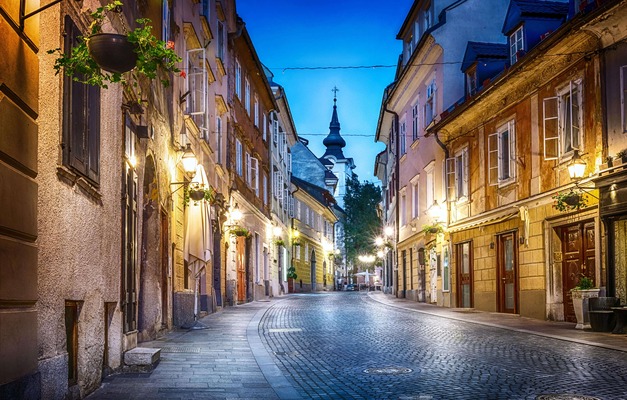
Spain's Cultural Treasures: Barcelona, Madrid & Seville
 10 Day Tour of Barcelona, Madrid and Seville
10 Day Tour of Barcelona, Madrid and Seville
Overview
Trip Map
Itinerary
Inclusions
Reviews







10 Days 9 Nights
Best Time: Jan-Dec
Cultural Exploration
History Buffs
Experience Spain's three largest and most vibrant cities with Go Real Travel's exclusive journey through Barcelona, Madrid, and Seville. Delight in the Gothic allure of Barcelona, the royal splendor of Madrid, and Seville's historic charm. Enjoy world-class tapas, iconic landmarks like the Sagrada Familia and Royal Palace, and private guided tours, including a full-day excursion to Gibraltar. Travel by high-speed rail, and enjoy detailed guidance via our mobile app for a seamless adventure. Uncover Spain’s beauty, history, and culture in this unforgettable voyage.
- Enter the awe-inspiring Sagrada Familia and discover the Modernist marvels in Barcelona.
- Enjoy panoramic views from Montjuïc Hill and the stunning beaches of Barceloneta.
- Explore Madrid's Royal Palace and the renowned art collections at the Prado Museum and Reina Sofia.
- Stroll Seville's historic heart, visiting the Alcazar and experiencing an authentic Flamenco evening
- Hang with locals in the vibrant Triana neighborhood and the lovely Parque de María Luisa in Seville.
Experience Spain's three largest and most vibrant cities with Go Real Travel's exclusive journey through Barcelona, Madrid, and Seville. Delight in the Gothic allure of Barcelona, the royal splendor of Madrid, and Seville's historic charm. Enjoy world-class tapas, iconic landmarks like the Sagrada Familia and Royal Palace, and private guided tours, including a full-day excursion to Gibraltar. Travel by high-speed rail, and enjoy detailed guidance via our mobile app for a seamless adventure. Uncover Spain’s beauty, history, and culture in this unforgettable voyage.
- Enter the awe-inspiring Sagrada Familia and discover the Modernist marvels in Barcelona.
- Enjoy panoramic views from Montjuïc Hill and the stunning beaches of Barceloneta.
- Explore Madrid's Royal Palace and the renowned art collections at the Prado Museum and Reina Sofia.
- Stroll Seville's historic heart, visiting the Alcazar and experiencing an authentic Flamenco evening
- Hang with locals in the vibrant Triana neighborhood and the lovely Parque de María Luisa in Seville.

Sagrada Familia
ArchitectureChurches & Monasteries

Park Güell
Parks & Gardens

The Royal Palace
UNESCO World Heritage

Alcazar
UNESCO World Heritage

Seville Cathedral
Churches & Monasteries

Plaza de Espana
Architecture

Santa Cruz
Jewish Heritage

Triana District
Neighborhood

Plaza de Toros
National Site
Must see sights

Sagrada Familia
ArchitectureChurches & Monasteries

Park Güell
Parks & Gardens

The Royal Palace
UNESCO World Heritage

Alcazar
UNESCO World Heritage

Seville Cathedral
Churches & Monasteries

Plaza de Espana
Architecture

Santa Cruz
Jewish Heritage

Triana District
Neighborhood

Plaza de Toros
National Site
Starting from
$2890
per person
 Not included
Not included Secure Your Customizable Trip
Enter your details to embark on a journey that can be tailored just for you.
Start
Travelers
Add Room
Remove Room
Preferred Hotel Stars
Craft Your Own Itinerary
Select your interests and destinations for a trip plan inspired by you.
Trip Map & Itinerary
Enable/Disable Map Scrolling
Click To Make Map Interactive

Trip Timeline
 Edit Details
Edit DetailsArrival
2 nights
Barcelona
Spain
Train: 3.5h
3 nights
Madrid
Spain
Train: 3h
4 nights
Seville
Spain
Departure
Day-By-Day Itinerary

Day 1
Arrive Barcelona
View More
Day 1
Arrive Barcelona


11:30 AM
Private Transfer from Airport
For your arrival in Barcelona, we will provide information on the customs and passport procedures. We will schedule a pick up for 30 minutes after your flight's arrival time. You will be met in the terminal by a driver holding a sign with your name on it. The ride is for your party only - you will not be sharing a vehicle. The cost of the ride will be included in your itinerary package. You will be taken directly to your hotel. IMPORTANT NOTE: Please be aware the car service can fit up to 1 checked item of luggage and 1 personal item per person, such as a purse or small backpack. If you think you will have more baggage, please inform your travel consultant as this may result in an additional fee.

Day 1
Arrive Barcelona
View More


Day 1
Arrive Barcelona



11:30 AM:
Airport Pick-Up
Mid-Day/Afternoon:
Gothic Quarter


Day 2
Barcelona
View More
Day 2
Barcelona



9:00 AM - 1:00 PM
Medieval & Modernist, the Highlights of Barcelona Tour
Discover the transformation of Barcelona from its Roman roots to a vibrant, modern metropolis, celebrated for its international flair and unique charm. Unveil the secrets of the iconic Sagrada Familia and explore the ancient Roman and medieval quarters. Experience history and architecture come alive through stories, legends, and the expert insights of an Official Barcelona Private Guide. From the majestic Plaça Nova to the historic Jewish Call, embark on a journey through time, punctuated by a delightful break with tea or coffee and churros in a classic café.

Day 2
Barcelona
View More



Day 3
Barcelona to Madrid
View More
Day 3
Barcelona to Madrid




Morning to Afternoon
Exploring Montjuïc Hill & MNAC Museum
Montjuïc Hill is a must-visit for its mix of cultural attractions and stunning green spaces. From the historic Montjuïc Castle, with its panoramic views, to the enchanting Magic Fountain and the rich collections at MNAC, there's plenty to see. Don't miss the Olympic Stadium, a key site of the 1992 Olympics, and Poble Espanyol's architectural representations from around Spain.

Joan Miró Foundation
Delve into the surreal and vibrant universe of one of the 20th century's most celebrated artists at the Joan Miró Foundation.
Show More

National Museum of Art of Catalonia
Immerse yourself in a rich collection of beautiful Catalan art spanning over a thousand years.
Show More

Montjuic Castle
Delve into Barcelona's rich history by visiting Montjuïc Castle, a strategic fortress offering breathtaking views of the city and the Mediterranean Sea.
Show More

Joan Miró Foundation
Delve into the surreal and vibrant universe of one of the 20th century's most celebrated artists at the Joan Miró Foundation.
Show More

National Museum of Art of Catalonia
Immerse yourself in a rich collection of beautiful Catalan art spanning over a thousand years.
Show More

Montjuic Castle
Delve into Barcelona's rich history by visiting Montjuïc Castle, a strategic fortress offering breathtaking views of the city and the Mediterranean Sea.
Show More

Joan Miró Foundation
Delve into the surreal and vibrant universe of one of the 20th century's most celebrated artists at the Joan Miró Foundation.
Show More
prev
next

Day 3
Barcelona to Madrid
View More

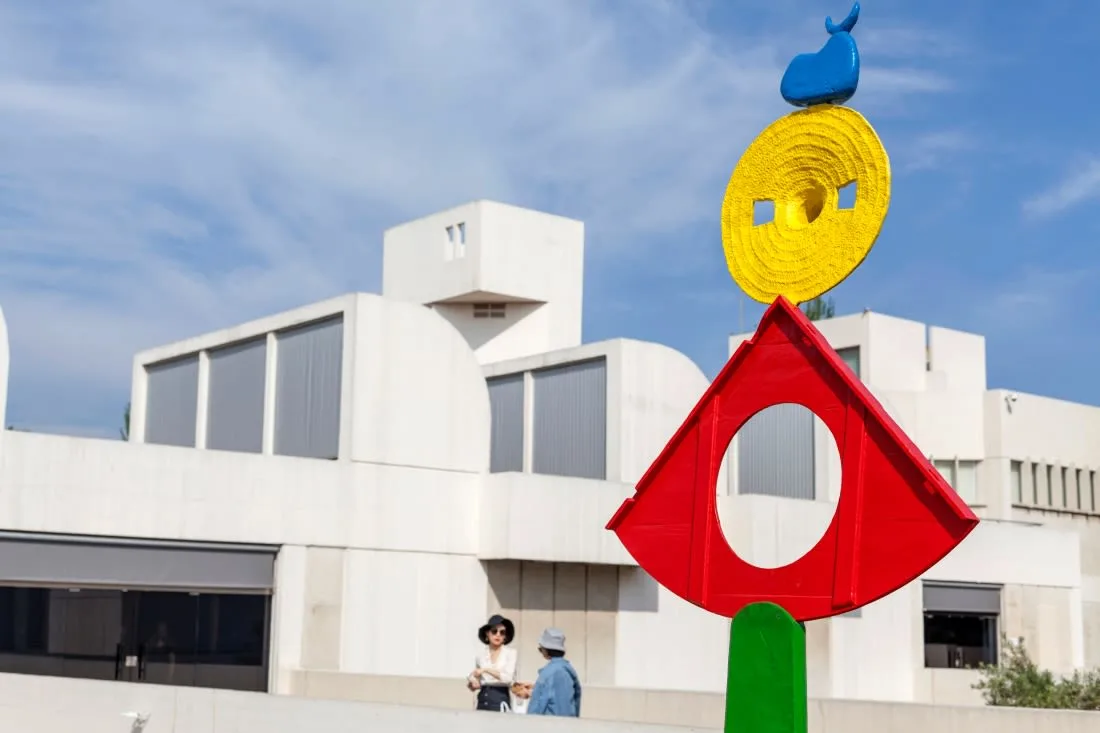
Joan Miró Foundation
 Highlight of Montjuïc Hill
Highlight of Montjuïc HillDelve into the surreal and vibrant universe of one of the 20th century's most celebrated artists at the Joan Miró Foundation.
Founded in 1975 by the artist himself, the Joan Miró Foundation is a cultural center dedicated to the works of the Catalan painter and sculptor Joan Miró. The foundation offers a comprehensive collection of Miró's works, including paintings, sculptures, textiles, and early sketches. The building, designed by Miró's friend Josep Lluís Sert, is a masterpiece of modern architecture. Visitors can enjoy temporary exhibitions, a sculpture garden, and panoramic views of Barcelona, making the foundation a must-visit for art lovers and tourists alike.

National Museum of Art of Catalonia
 Highlight of Montjuïc Hill
Highlight of Montjuïc HillImmerse yourself in a rich collection of beautiful Catalan art spanning over a thousand years.
Located in the magnificent Palau Nacional on Montjuïc hill, the National Museum of Catalan Art boasts an extensive collection that traces the evolution of Catalan art from the Romanesque period to the mid-20th century. The museum is renowned for its exceptional Romanesque frescoes, which are considered some of the finest in the world. The museum's terrace offers breathtaking views of Barcelona, providing a perfect complement to the artistic journey within.

Montjuic Castle
 Highlight of Montjuïc Hill
Highlight of Montjuïc HillDelve into Barcelona's rich history by visiting Montjuïc Castle, a strategic fortress offering breathtaking views of the city and the Mediterranean Sea.
Montjuïc Castle, perched atop Montjuïc hill, has been a Barcelona landmark since its construction in the 17th century. Initially built as a military fortress, the castle has witnessed various pivotal moments in the city's history, including sieges and civil conflicts. Today, it serves as a cultural site and museum, showcasing exhibitions on its military past and offering insights into Catalonia's history. The castle's walls provide panoramic views of Barcelona's skyline, the bustling port, and the sparkling Mediterranean Sea.

Joan Miró Foundation
 Highlight of Montjuïc Hill
Highlight of Montjuïc HillDelve into the surreal and vibrant universe of one of the 20th century's most celebrated artists at the Joan Miró Foundation.
Founded in 1975 by the artist himself, the Joan Miró Foundation is a cultural center dedicated to the works of the Catalan painter and sculptor Joan Miró. The foundation offers a comprehensive collection of Miró's works, including paintings, sculptures, textiles, and early sketches. The building, designed by Miró's friend Josep Lluís Sert, is a masterpiece of modern architecture. Visitors can enjoy temporary exhibitions, a sculpture garden, and panoramic views of Barcelona, making the foundation a must-visit for art lovers and tourists alike.

National Museum of Art of Catalonia
 Highlight of Montjuïc Hill
Highlight of Montjuïc HillImmerse yourself in a rich collection of beautiful Catalan art spanning over a thousand years.
Located in the magnificent Palau Nacional on Montjuïc hill, the National Museum of Catalan Art boasts an extensive collection that traces the evolution of Catalan art from the Romanesque period to the mid-20th century. The museum is renowned for its exceptional Romanesque frescoes, which are considered some of the finest in the world. The museum's terrace offers breathtaking views of Barcelona, providing a perfect complement to the artistic journey within.

Montjuic Castle
 Highlight of Montjuïc Hill
Highlight of Montjuïc HillDelve into Barcelona's rich history by visiting Montjuïc Castle, a strategic fortress offering breathtaking views of the city and the Mediterranean Sea.
Montjuïc Castle, perched atop Montjuïc hill, has been a Barcelona landmark since its construction in the 17th century. Initially built as a military fortress, the castle has witnessed various pivotal moments in the city's history, including sieges and civil conflicts. Today, it serves as a cultural site and museum, showcasing exhibitions on its military past and offering insights into Catalonia's history. The castle's walls provide panoramic views of Barcelona's skyline, the bustling port, and the sparkling Mediterranean Sea.

Joan Miró Foundation
 Highlight of Montjuïc Hill
Highlight of Montjuïc HillDelve into the surreal and vibrant universe of one of the 20th century's most celebrated artists at the Joan Miró Foundation.
Founded in 1975 by the artist himself, the Joan Miró Foundation is a cultural center dedicated to the works of the Catalan painter and sculptor Joan Miró. The foundation offers a comprehensive collection of Miró's works, including paintings, sculptures, textiles, and early sketches. The building, designed by Miró's friend Josep Lluís Sert, is a masterpiece of modern architecture. Visitors can enjoy temporary exhibitions, a sculpture garden, and panoramic views of Barcelona, making the foundation a must-visit for art lovers and tourists alike.
prev
next


Day 4
Madrid
View More
Day 4
Madrid




9:30 AM - 12:30 PM
Highlights of Madrid Private Walking Tour
Immerse yourself in the heart of Spanish history with a captivating 3-hour walking tour in Madrid, focusing on the majestic Royal Palace (exterior) and the bustling Plaza Mayor. At the Royal Palace, you will learn how the Habsburg Empire came to Spain, grew to cover the New World, and then discovered that the Iberian peninsula was enough land. Then, meander toward the vibrant Plaza Mayor, a grand square framed by historic buildings, lively cafes, and street performers. Among the frescos of these Baroque buildings you'll hear Madrid's history, the good and the bad, the everyday and the dramatic. Through it all, you will have the chance to see and hear the buzz of life the proceeds from Spain's capital!

Day 4
Madrid
View More


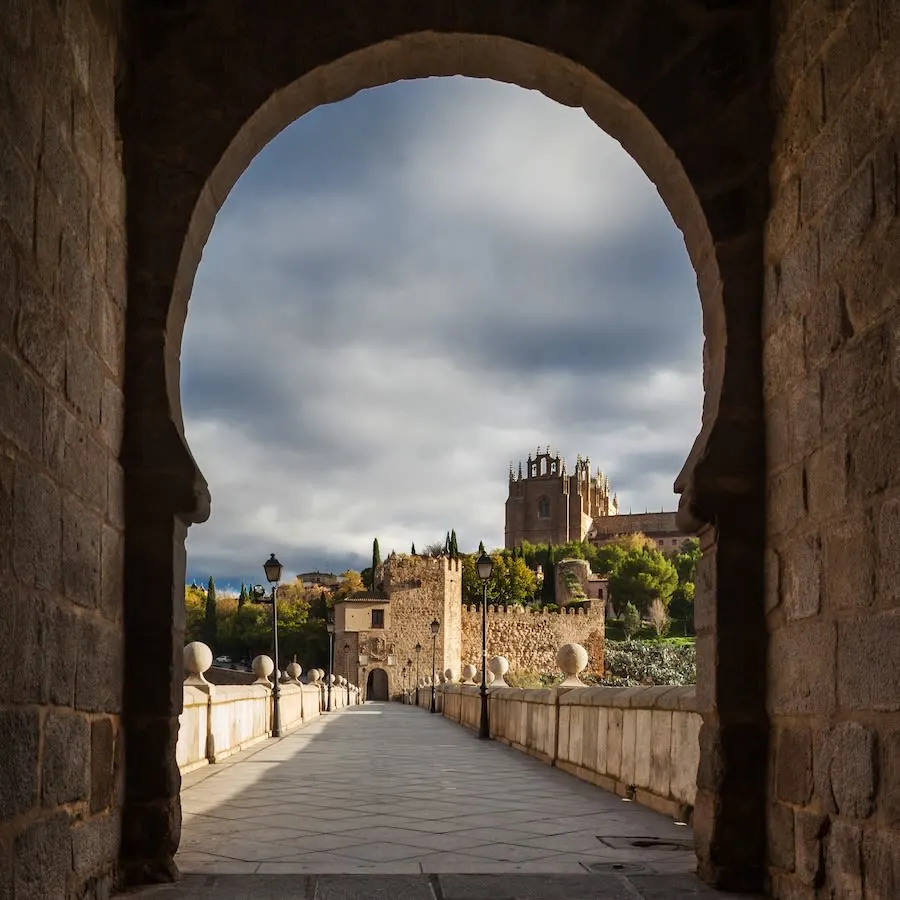
Day 5
Madrid
View More
Day 5
Madrid



Morning to Afternoon
Self-Guided Excursion to Majestic Toledo
Toledo, a city of majestic history and cultural diversity, offers an unparalleled journey back in time. With its well-preserved medieval architecture, including the grand Toledo Cathedral, the historic Alcázar, and the serene Synagogue of Santa María la Blanca, visitors are transported to a bygone era. The Monastery of San Juan de los Reyes and the picturesque Puente de San Martín further accentuate the city's rich historical tapestry. Beyond its historical significance, Toledo's narrow, winding streets and the stunning views over the Tagus River capture the essence of Spanish beauty. This day trip is essential to experience Spain's multifaceted heritage, offering a perfect blend of architectural marvels, religious significance, and breathtaking landscapes. Included: Roundtrip high-speed rail tickets to Lisbon

Toledo Cathedral
Marvel at the grandiosity of this Cathedral, and listen quietly to discover a 6th-century rite of ancient Christianity.
Show More

El Greco Museum
Wander past the long, sometimes eerie, figures the draw us into a mystical past.
Show More

Cristo de la Luz Mosque
There's a lot of history here, some of it contentious.
Show More

Alcázar of Toledo
Follow the Romans, Visigoths, and Moors to the historic fortress of Toledo.
Show More

Synagogue of Santa María la Blanca
Explore the serene and unusual Synagogue of Santa María la Blanca.
Show More

Monastery of San Juan de los Reyes
Walk the hallowed cloisters of the Monastery of San Juan de los Reyes.
Show More

Toledo Cathedral
Marvel at the grandiosity of this Cathedral, and listen quietly to discover a 6th-century rite of ancient Christianity.
Show More

El Greco Museum
Wander past the long, sometimes eerie, figures the draw us into a mystical past.
Show More

Cristo de la Luz Mosque
There's a lot of history here, some of it contentious.
Show More

Alcázar of Toledo
Follow the Romans, Visigoths, and Moors to the historic fortress of Toledo.
Show More

Synagogue of Santa María la Blanca
Explore the serene and unusual Synagogue of Santa María la Blanca.
Show More

Monastery of San Juan de los Reyes
Walk the hallowed cloisters of the Monastery of San Juan de los Reyes.
Show More
prev
next

Day 5
Madrid
View More

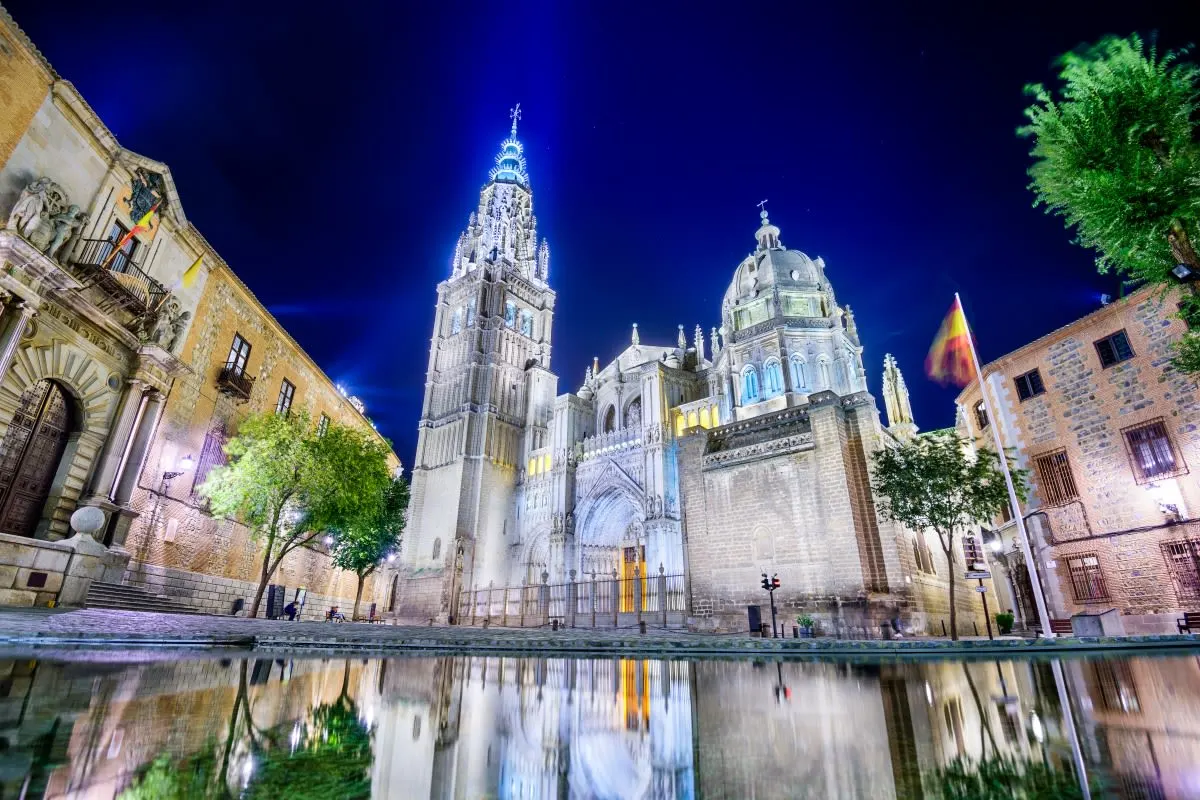
Toledo Cathedral
 Highlight of Excursion to Toledo
Highlight of Excursion to Toledo Marvel at the grandiosity of this Cathedral, and listen quietly to discover a 6th-century rite of ancient Christianity.
While the Cathedral of Toledo contains many architectural styles, ranging from Romanesque and Gothic through early Baroque, contains artistic treasures like El Transparente and paintings from the likes of Velásquez, Goya, and El Greco, its greatest curiosity might be the celebration of the ancient Mozarabic rite and traditions. The songs and chants of this rite hearken back to the controversies and challenges not of the 1950s, nor the 1550s, but the 550s. All that turmoil makes for some serious beauty now...

El Greco Museum
 Highlight of Excursion to Toledo
Highlight of Excursion to Toledo Wander past the long, sometimes eerie, figures the draw us into a mystical past.
Dedicated to Domenikos Theotokopoulos, better known as El Greco, this museum explores the masterpainter who spent much of his working life in this historic city. Located in the Jewish Quarter in a house inaccurately purported to have been his home, the museum replicates the atmosphere of the period and showcases an extensive collection of his paintings. Opened in 1911, the museum aims to celebrate El Greco's unique style, characterized by elongated figures and vibrant colors. Highlights include some of his most famous works that reflect his deep religious sentiment and innovative approach to Mannerism.
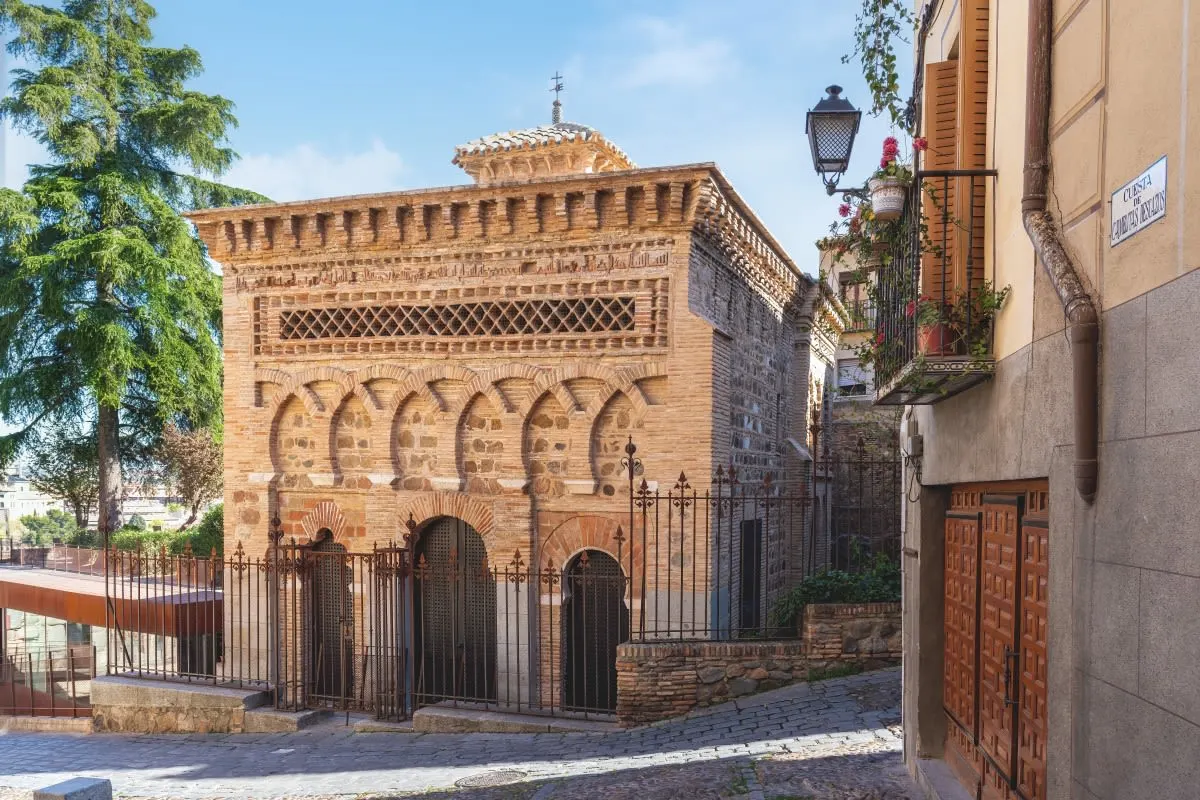
Cristo de la Luz Mosque
 Highlight of Excursion to Toledo
Highlight of Excursion to Toledo There's a lot of history here, some of it contentious.
The Cristo de la Luz Mosque in Toledo, originally named Bab al-Mardum Mosque, is a rare architectural relic dating back to the year 999, during the reign of Moorish Caliph Abd ar-Rahman III. This small but significant building is one of the ten that survive from the Moorish period in the city. Remarkably well-preserved, it showcases the blend of Visigothic and Islamic architectural styles that are unique to Spain. Under the 12th-century apse, it even retains some Christian carvings from the 3rd century. After the Christian reconquest of Toledo in the 12th century, the mosque was converted into a church, but it retained its original Islamic brickwork, arches, and geometric decoration. Today, the church-turned-mosque-turneded-church serves as a museum.
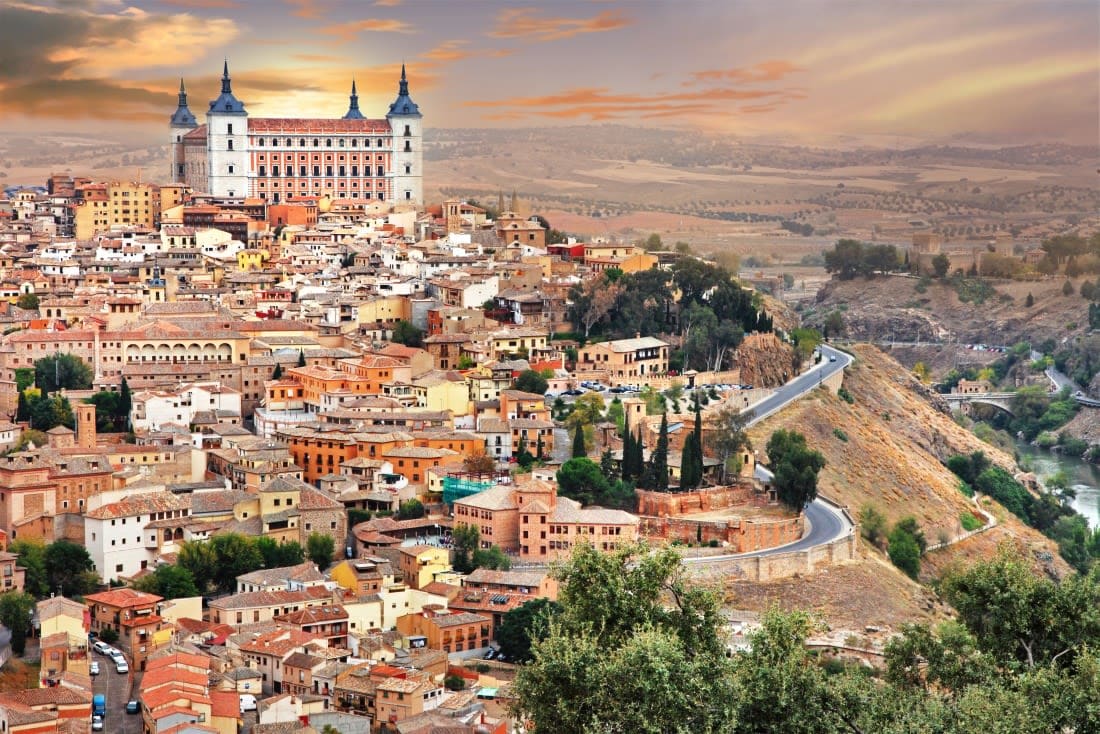
Alcázar of Toledo
 Highlight of Excursion to Toledo
Highlight of Excursion to Toledo Follow the Romans, Visigoths, and Moors to the historic fortress of Toledo.
The Alcázar of Toledo is a historic fortress that dominates the city's skyline. Originating as a Roman palace in the 3rd century, it was transformed through the centuries by Visigoths, Moors, and Christians into the imposing structure seen today. Reconstructed under Charles V in the 16th century with a Renaissance flair, the Alcázar's strategic location offers panoramic views over Toledo and its surrounding landscape, making its military usefulness clear. After withstanding a prolonged siege in the Spanish Civil War by Republican forces, Spain's Nationalist dictator Franco decided to house the Army Museum within the fortress. Today the museum's exhibits span the breadth of Spanish military history, from ancient weapons to modern-day peacekeeping missions.
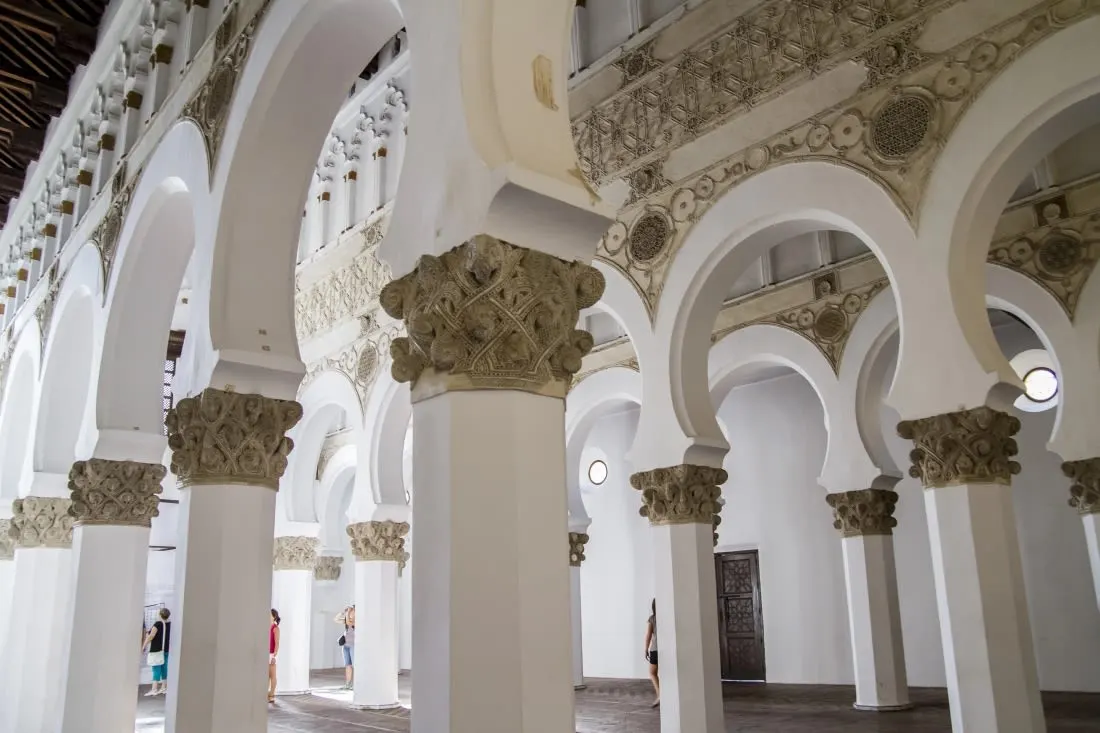
Synagogue of Santa María la Blanca
 Highlight of Excursion to Toledo
Highlight of Excursion to Toledo Explore the serene and unusual Synagogue of Santa María la Blanca.
The Synagogue of Santa María la Blanca stands as a rare example of Mudejar architecture, the unique and beautiful style of building that resulted from the mixing of Jewish, Islamic, and Christian building styles. It was seized from the Jewish community and converted into a church in the later Middle Ages, and as a result you have the unusual opportunity to visit a building known simultaneously as a synagogue and by the name of a Christian saint. It is also unusual in that the stark white horseshoe arches and tranquil atmosphere are set in an atypical floorplan, which is divided into five aisles with the central nave aisle being only slightly larger than the others. The former synagogue thus encapsulates a unique blend of cultural, architectural, and religious histories within its walls.
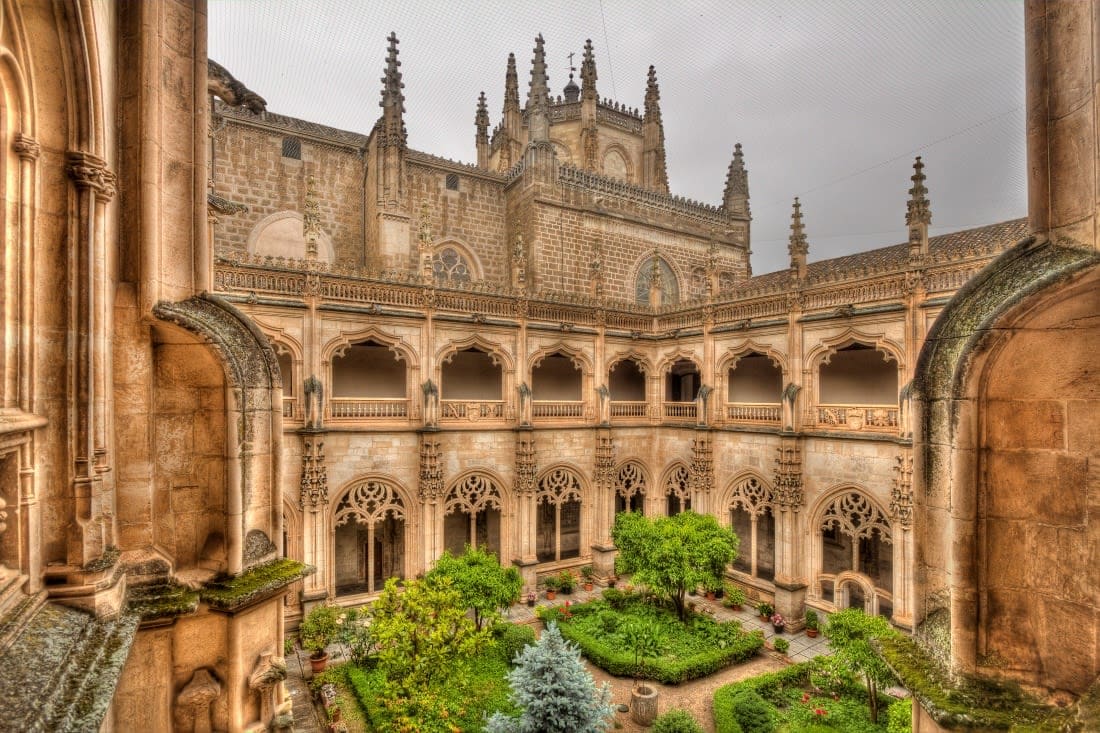
Monastery of San Juan de los Reyes
 Highlight of Excursion to Toledo
Highlight of Excursion to Toledo Walk the hallowed cloisters of the Monastery of San Juan de los Reyes.
This 15th century monastery is a masterpiece of late Gothic style. It was commissioned by Isabella I and her husband Ferdinand II (the monarchs who sent Columbus to the New World), who wished to commemorate their victory at Toro where they consolidated their rule over Spain. Its elaborate stonework and cloisters offer many pleasant surprises, while the church's altarpiece, choir, and sacristy are richly decorated, housing important works of art, including paintings, sculptures, and gold work. The gardens, meanwhile, offer a tranquil space to relax and contemplate the beauty of the setting. Also interesting to note that are chains hanging from the walls of the monastery. They came from Christian slaves who were rescued from captivity in Muslim territories, primarily in North Africa, and are a reminder of often forgotten but quite significant chapter in Spanish history. Hundreds of thousands of Spaniards were enslaved in Northern Africa.

Toledo Cathedral
 Highlight of Excursion to Toledo
Highlight of Excursion to Toledo Marvel at the grandiosity of this Cathedral, and listen quietly to discover a 6th-century rite of ancient Christianity.
While the Cathedral of Toledo contains many architectural styles, ranging from Romanesque and Gothic through early Baroque, contains artistic treasures like El Transparente and paintings from the likes of Velásquez, Goya, and El Greco, its greatest curiosity might be the celebration of the ancient Mozarabic rite and traditions. The songs and chants of this rite hearken back to the controversies and challenges not of the 1950s, nor the 1550s, but the 550s. All that turmoil makes for some serious beauty now...

El Greco Museum
 Highlight of Excursion to Toledo
Highlight of Excursion to Toledo Wander past the long, sometimes eerie, figures the draw us into a mystical past.
Dedicated to Domenikos Theotokopoulos, better known as El Greco, this museum explores the masterpainter who spent much of his working life in this historic city. Located in the Jewish Quarter in a house inaccurately purported to have been his home, the museum replicates the atmosphere of the period and showcases an extensive collection of his paintings. Opened in 1911, the museum aims to celebrate El Greco's unique style, characterized by elongated figures and vibrant colors. Highlights include some of his most famous works that reflect his deep religious sentiment and innovative approach to Mannerism.

Cristo de la Luz Mosque
 Highlight of Excursion to Toledo
Highlight of Excursion to Toledo There's a lot of history here, some of it contentious.
The Cristo de la Luz Mosque in Toledo, originally named Bab al-Mardum Mosque, is a rare architectural relic dating back to the year 999, during the reign of Moorish Caliph Abd ar-Rahman III. This small but significant building is one of the ten that survive from the Moorish period in the city. Remarkably well-preserved, it showcases the blend of Visigothic and Islamic architectural styles that are unique to Spain. Under the 12th-century apse, it even retains some Christian carvings from the 3rd century. After the Christian reconquest of Toledo in the 12th century, the mosque was converted into a church, but it retained its original Islamic brickwork, arches, and geometric decoration. Today, the church-turned-mosque-turneded-church serves as a museum.

Alcázar of Toledo
 Highlight of Excursion to Toledo
Highlight of Excursion to Toledo Follow the Romans, Visigoths, and Moors to the historic fortress of Toledo.
The Alcázar of Toledo is a historic fortress that dominates the city's skyline. Originating as a Roman palace in the 3rd century, it was transformed through the centuries by Visigoths, Moors, and Christians into the imposing structure seen today. Reconstructed under Charles V in the 16th century with a Renaissance flair, the Alcázar's strategic location offers panoramic views over Toledo and its surrounding landscape, making its military usefulness clear. After withstanding a prolonged siege in the Spanish Civil War by Republican forces, Spain's Nationalist dictator Franco decided to house the Army Museum within the fortress. Today the museum's exhibits span the breadth of Spanish military history, from ancient weapons to modern-day peacekeeping missions.

Synagogue of Santa María la Blanca
 Highlight of Excursion to Toledo
Highlight of Excursion to Toledo Explore the serene and unusual Synagogue of Santa María la Blanca.
The Synagogue of Santa María la Blanca stands as a rare example of Mudejar architecture, the unique and beautiful style of building that resulted from the mixing of Jewish, Islamic, and Christian building styles. It was seized from the Jewish community and converted into a church in the later Middle Ages, and as a result you have the unusual opportunity to visit a building known simultaneously as a synagogue and by the name of a Christian saint. It is also unusual in that the stark white horseshoe arches and tranquil atmosphere are set in an atypical floorplan, which is divided into five aisles with the central nave aisle being only slightly larger than the others. The former synagogue thus encapsulates a unique blend of cultural, architectural, and religious histories within its walls.

Monastery of San Juan de los Reyes
 Highlight of Excursion to Toledo
Highlight of Excursion to Toledo Walk the hallowed cloisters of the Monastery of San Juan de los Reyes.
This 15th century monastery is a masterpiece of late Gothic style. It was commissioned by Isabella I and her husband Ferdinand II (the monarchs who sent Columbus to the New World), who wished to commemorate their victory at Toro where they consolidated their rule over Spain. Its elaborate stonework and cloisters offer many pleasant surprises, while the church's altarpiece, choir, and sacristy are richly decorated, housing important works of art, including paintings, sculptures, and gold work. The gardens, meanwhile, offer a tranquil space to relax and contemplate the beauty of the setting. Also interesting to note that are chains hanging from the walls of the monastery. They came from Christian slaves who were rescued from captivity in Muslim territories, primarily in North Africa, and are a reminder of often forgotten but quite significant chapter in Spanish history. Hundreds of thousands of Spaniards were enslaved in Northern Africa.
prev
next

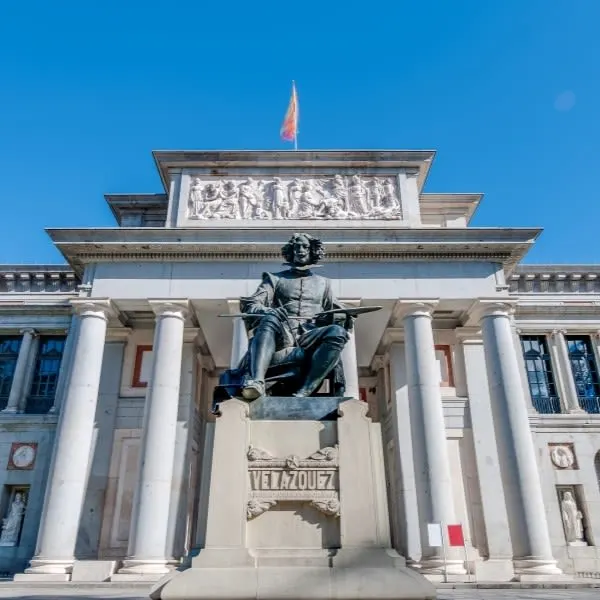
Day 6
Madrid to Seville
View More
Day 6
Madrid to Seville





Morning
Discover Madrid's Art Triangle on the Paseo del Prado
Madrid's Art Triangle, nestled along the magnificent avenue known as the Paseo del Prado, draws art lovers from around the world. And while the triangle itself is obtuse, the art isn't: its three major museums contain some of the most prestigious and recognizable art in the world. The Prado awes with its distinguished collection of European masters; the Thyssen-Bornemisza, journeys through art history from the Renaissance to Modernism; and, the Reina Sofía, home to Picasso's "Guernica" pays tribute to to Spain's impressive heritage of modern art. Numerous other museums and even a lovely botanical garden are also within steps of the main attractions.

Reina Sofía Museum
Take a deep dive in Spain's modern art movement
Show More

Royal Botanical Garden
Discover an historic oasis in the heart of Madrid.
Show More

CaixaForum Madrid
What does Spain enter culture and art today? Find out here.
Show More

Prado Museum
Marvel at one of the world's greatest art collections...
Show More

Thyssen-Bornemisza Museum
Explore an unparalleled private art collection
Show More

Reina Sofía Museum
Take a deep dive in Spain's modern art movement
Show More

Royal Botanical Garden
Discover an historic oasis in the heart of Madrid.
Show More

CaixaForum Madrid
What does Spain enter culture and art today? Find out here.
Show More

Prado Museum
Marvel at one of the world's greatest art collections...
Show More

Thyssen-Bornemisza Museum
Explore an unparalleled private art collection
Show More

Reina Sofía Museum
Take a deep dive in Spain's modern art movement
Show More
prev
next

Day 6
Madrid to Seville
View More

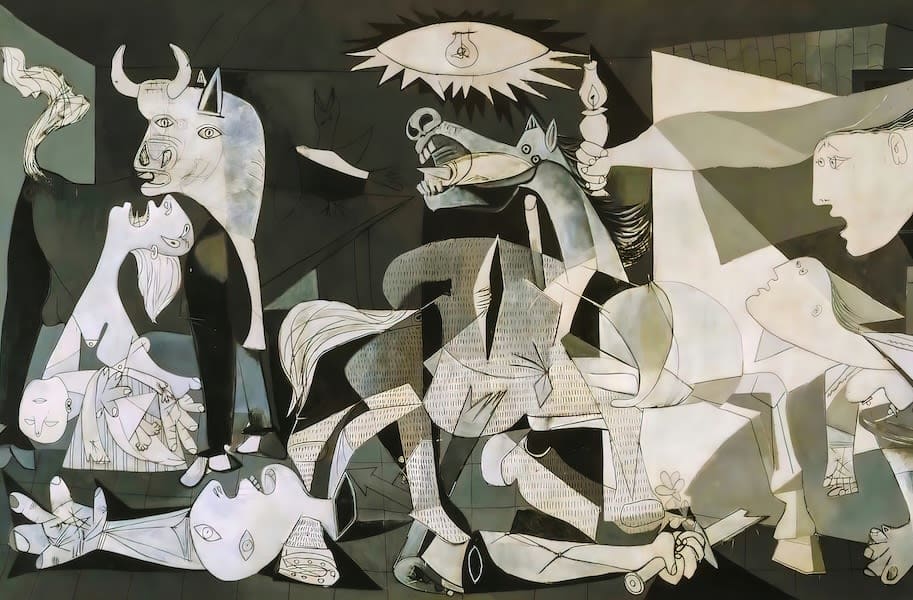
Reina Sofía Museum
 Highlight of Art Triangle
Highlight of Art TriangleTake a deep dive in Spain's modern art movement
The Reina Sofía Museum is dedicated to modern and contemporary art, with a particular focus on Spanish artists. Internationally renowned for housing Picasso's powerful anti-war masterpiece, "Guernica." The museum's collections also feature significant works by Salvador Dalí, Joan Miró, and Juan Gris, among others, showcasing the expansive influence of 20th-century Spanish art.
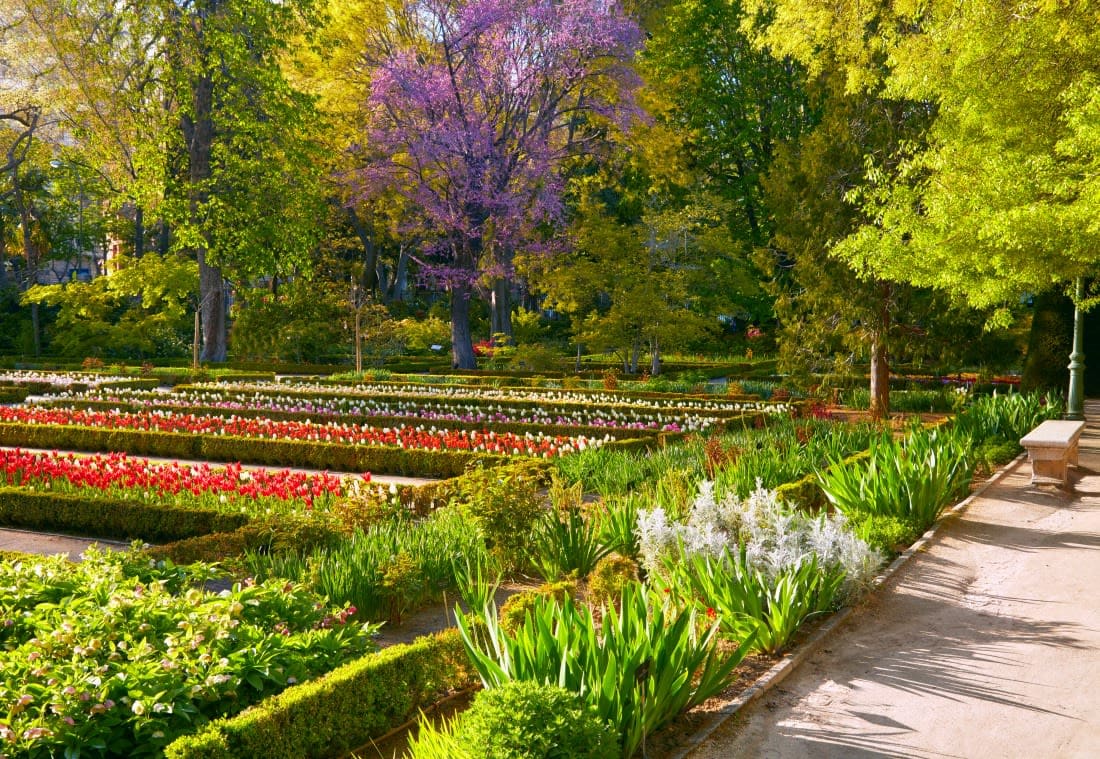
Royal Botanical Garden
 Highlight of Art Triangle
Highlight of Art TriangleDiscover an historic oasis in the heart of Madrid.
Established by King Ferdinand VI in 1755, the Royal Botanical Garden offers a retreat from the hurly-burly of Madrid. With its extensive collection of plants from around the globe, visitors can explore thematic gardens, historical herbariums, and vibrant floral displays that change with the seasons. This living museum provides a serene escape while simultaneously educating its visitors on biodiversity, conservation, and the importance of plant life in our world.
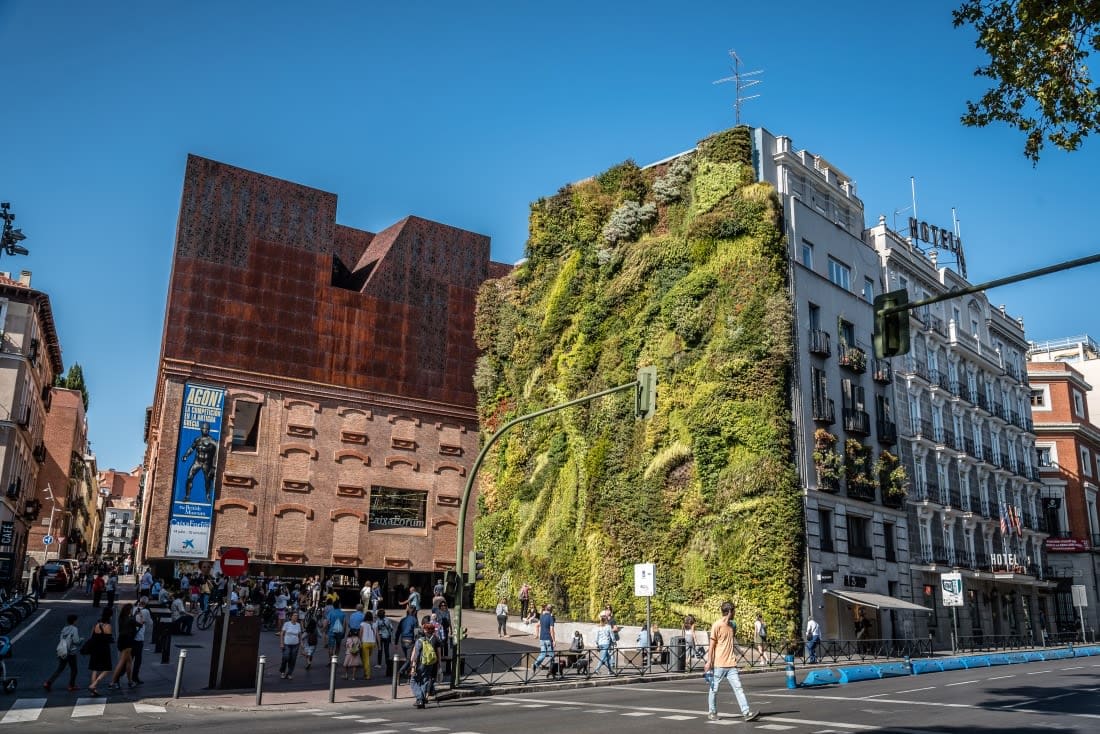
CaixaForum Madrid
 Highlight of Art Triangle
Highlight of Art TriangleWhat does Spain enter culture and art today? Find out here.
CaixaForum Madrid, housed in a strikingly renovated former power station, is a modern social and cultural center that hosts a dynamic array of exhibitions, from ancient arts to contemporary installations. Its vertical garden and varied program, including music, poetry readings, and educational workshops, make it a hub of artistic and cultural innovation in the heart of Madrid.

Prado Museum
 Highlight of Art Triangle
Highlight of Art TriangleMarvel at one of the world's greatest art collections...
Lose yourself in the Prado Museum, the cornerstone of Madrid's Art Triangle housing a breathtaking collection of European art, from the Middle Ages to the 19th century. Adorned with masterpieces by Velázquez, Goya, Rubens, an der Weyden, and Bosch make it a world-class museum. The first two artists, the Spainards Velázquez and Goya, recieve thorough treatment here, and one can fully appreciate the breadth and arc of their careers.
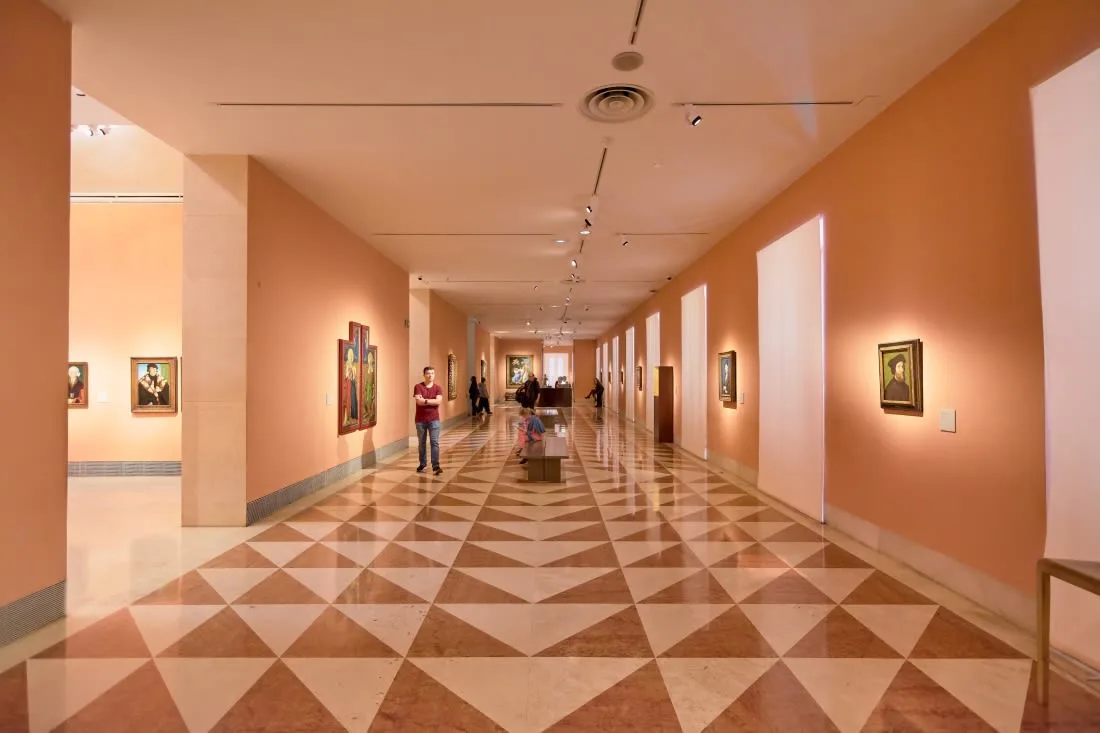
Thyssen-Bornemisza Museum
 Highlight of Art Triangle
Highlight of Art TriangleExplore an unparalleled private art collection
The Thyssen-Bornemisza Museum... to walk its halls and read its artists' name, one might get a feeling of dejá-vu. We've seen the paintings, heard of these names before - the museum is nearly a comprehensive of who's-who of popular art from the 13th to the 20th centuries. From Duccio to Van Eck to Dürer to Caravaggio to Rembrandt to Renoir, Van Gogh, Monet, and on and on down to Hopper and Pollock. This museum complements its counterparts by covering artistic periods and styles not extensively represented in the other two, providing a panoramic view of the last 800 years of Western art.

Reina Sofía Museum
 Highlight of Art Triangle
Highlight of Art TriangleTake a deep dive in Spain's modern art movement
The Reina Sofía Museum is dedicated to modern and contemporary art, with a particular focus on Spanish artists. Internationally renowned for housing Picasso's powerful anti-war masterpiece, "Guernica." The museum's collections also feature significant works by Salvador Dalí, Joan Miró, and Juan Gris, among others, showcasing the expansive influence of 20th-century Spanish art.

Royal Botanical Garden
 Highlight of Art Triangle
Highlight of Art TriangleDiscover an historic oasis in the heart of Madrid.
Established by King Ferdinand VI in 1755, the Royal Botanical Garden offers a retreat from the hurly-burly of Madrid. With its extensive collection of plants from around the globe, visitors can explore thematic gardens, historical herbariums, and vibrant floral displays that change with the seasons. This living museum provides a serene escape while simultaneously educating its visitors on biodiversity, conservation, and the importance of plant life in our world.

CaixaForum Madrid
 Highlight of Art Triangle
Highlight of Art TriangleWhat does Spain enter culture and art today? Find out here.
CaixaForum Madrid, housed in a strikingly renovated former power station, is a modern social and cultural center that hosts a dynamic array of exhibitions, from ancient arts to contemporary installations. Its vertical garden and varied program, including music, poetry readings, and educational workshops, make it a hub of artistic and cultural innovation in the heart of Madrid.

Prado Museum
 Highlight of Art Triangle
Highlight of Art TriangleMarvel at one of the world's greatest art collections...
Lose yourself in the Prado Museum, the cornerstone of Madrid's Art Triangle housing a breathtaking collection of European art, from the Middle Ages to the 19th century. Adorned with masterpieces by Velázquez, Goya, Rubens, an der Weyden, and Bosch make it a world-class museum. The first two artists, the Spainards Velázquez and Goya, recieve thorough treatment here, and one can fully appreciate the breadth and arc of their careers.

Thyssen-Bornemisza Museum
 Highlight of Art Triangle
Highlight of Art TriangleExplore an unparalleled private art collection
The Thyssen-Bornemisza Museum... to walk its halls and read its artists' name, one might get a feeling of dejá-vu. We've seen the paintings, heard of these names before - the museum is nearly a comprehensive of who's-who of popular art from the 13th to the 20th centuries. From Duccio to Van Eck to Dürer to Caravaggio to Rembrandt to Renoir, Van Gogh, Monet, and on and on down to Hopper and Pollock. This museum complements its counterparts by covering artistic periods and styles not extensively represented in the other two, providing a panoramic view of the last 800 years of Western art.

Reina Sofía Museum
 Highlight of Art Triangle
Highlight of Art TriangleTake a deep dive in Spain's modern art movement
The Reina Sofía Museum is dedicated to modern and contemporary art, with a particular focus on Spanish artists. Internationally renowned for housing Picasso's powerful anti-war masterpiece, "Guernica." The museum's collections also feature significant works by Salvador Dalí, Joan Miró, and Juan Gris, among others, showcasing the expansive influence of 20th-century Spanish art.
prev
next

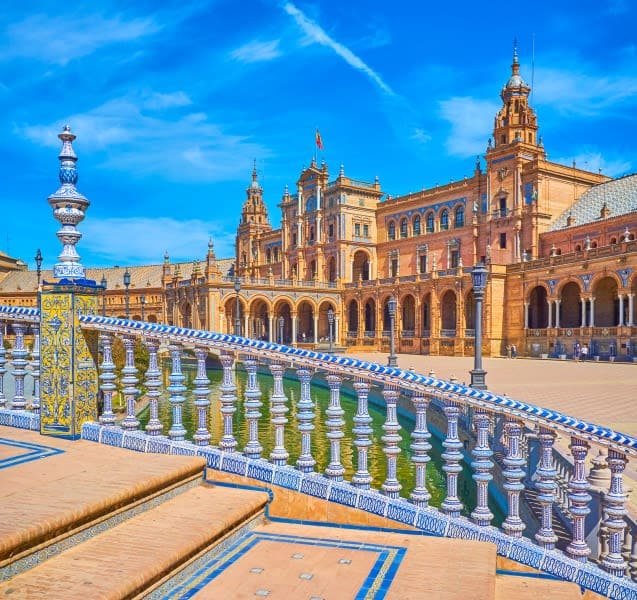
Day 7
Seville
View More
Day 7
Seville



9:00 AM - 12:30 PM
Guided Tour of the Highlights of Seville including the Royal Alcazar
Walk with your private guide and discover the long, eventful history of Seville. From Roman walls built at the command of Julius Caesar to the Royal Alcazar Palace of the Caliphs, from and St. Mary's Cathedral, a repurposed mosque, to the General Archive ofthe Indies containing the early records of New World exploration, this tour will amaze you. Your guide will help you skip the lines for the Alcazar, one of the triumphs of Moorish architecture, to illustrate the many winds of history that have blown through Seville's streets.

Seville Alcazar
The Seville Alcázar, a UNESCO World Heritage site, is a stunning blend of Mudéjar, Gothic, Renaissance, and Baroque architecture. Originally a 10th-century fortress, it features the exquisite Patio de las Doncellas, the grand Salón de Embajadores, and lush, expansive gardens.
Show More

Seville Alcazar
The Seville Alcázar, a UNESCO World Heritage site, is a stunning blend of Mudéjar, Gothic, Renaissance, and Baroque architecture. Originally a 10th-century fortress, it features the exquisite Patio de las Doncellas, the grand Salón de Embajadores, and lush, expansive gardens.
Show More

Seville Alcazar
The Seville Alcázar, a UNESCO World Heritage site, is a stunning blend of Mudéjar, Gothic, Renaissance, and Baroque architecture. Originally a 10th-century fortress, it features the exquisite Patio de las Doncellas, the grand Salón de Embajadores, and lush, expansive gardens.
Show More

Seville Alcazar
The Seville Alcázar, a UNESCO World Heritage site, is a stunning blend of Mudéjar, Gothic, Renaissance, and Baroque architecture. Originally a 10th-century fortress, it features the exquisite Patio de las Doncellas, the grand Salón de Embajadores, and lush, expansive gardens.
Show More

Seville Alcazar
The Seville Alcázar, a UNESCO World Heritage site, is a stunning blend of Mudéjar, Gothic, Renaissance, and Baroque architecture. Originally a 10th-century fortress, it features the exquisite Patio de las Doncellas, the grand Salón de Embajadores, and lush, expansive gardens.
Show More
prev
next

Day 7
Seville
View More

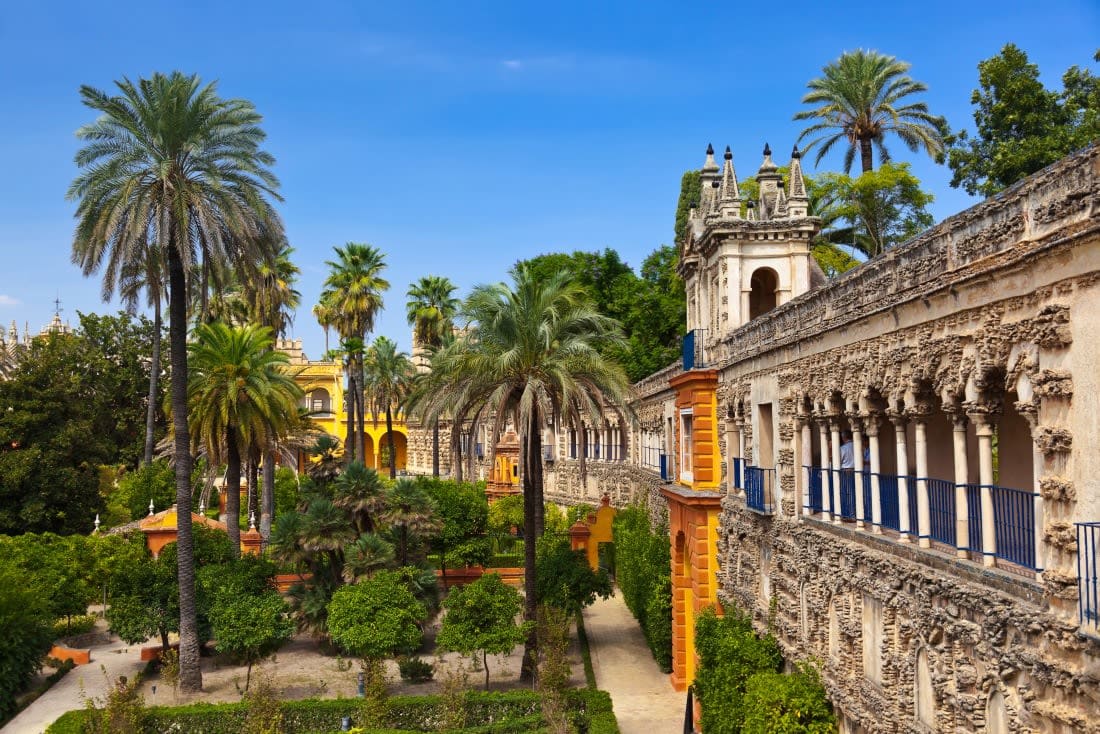
Seville Alcazar
 Highlight of Guided Highlights & Alcazar
Highlight of Guided Highlights & AlcazarThe Seville Alcázar, a UNESCO World Heritage site, is a stunning blend of Mudéjar, Gothic, Renaissance, and Baroque architecture. Originally a 10th-century fortress, it features the exquisite Patio de las Doncellas, the grand Salón de Embajadores, and lush, expansive gardens.
The Seville Alcázar, a UNESCO World Heritage site, stands as a testament to Spain's rich cultural history and architectural prowess. Originally built in the 10th century as a fortress for the Cordoban governors of Seville, the Alcázar was later transformed into a magnificent royal palace. This evolution resulted in a unique blend of Mudéjar, Gothic, Renaissance, and Baroque styles, creating a visually stunning and historically significant monument. Visitors can explore the enchanting Patio de las Doncellas, a courtyard renowned for its intricate tilework and lush greenery. The Salón de Embajadores, once the site of grand state affairs, dazzles with its elaborate decoration and regal ambiance. The Alcázar's expansive gardens are a highlight, featuring tranquil fountains, fragrant orange trees, and meticulously maintained landscapes. These gardens offer a serene escape and a vivid glimpse into the luxurious lifestyles of Spain's Moorish and Christian rulers.

Seville Alcazar
 Highlight of Guided Highlights & Alcazar
Highlight of Guided Highlights & AlcazarThe Seville Alcázar, a UNESCO World Heritage site, is a stunning blend of Mudéjar, Gothic, Renaissance, and Baroque architecture. Originally a 10th-century fortress, it features the exquisite Patio de las Doncellas, the grand Salón de Embajadores, and lush, expansive gardens.
The Seville Alcázar, a UNESCO World Heritage site, stands as a testament to Spain's rich cultural history and architectural prowess. Originally built in the 10th century as a fortress for the Cordoban governors of Seville, the Alcázar was later transformed into a magnificent royal palace. This evolution resulted in a unique blend of Mudéjar, Gothic, Renaissance, and Baroque styles, creating a visually stunning and historically significant monument. Visitors can explore the enchanting Patio de las Doncellas, a courtyard renowned for its intricate tilework and lush greenery. The Salón de Embajadores, once the site of grand state affairs, dazzles with its elaborate decoration and regal ambiance. The Alcázar's expansive gardens are a highlight, featuring tranquil fountains, fragrant orange trees, and meticulously maintained landscapes. These gardens offer a serene escape and a vivid glimpse into the luxurious lifestyles of Spain's Moorish and Christian rulers.

Seville Alcazar
 Highlight of Guided Highlights & Alcazar
Highlight of Guided Highlights & AlcazarThe Seville Alcázar, a UNESCO World Heritage site, is a stunning blend of Mudéjar, Gothic, Renaissance, and Baroque architecture. Originally a 10th-century fortress, it features the exquisite Patio de las Doncellas, the grand Salón de Embajadores, and lush, expansive gardens.
The Seville Alcázar, a UNESCO World Heritage site, stands as a testament to Spain's rich cultural history and architectural prowess. Originally built in the 10th century as a fortress for the Cordoban governors of Seville, the Alcázar was later transformed into a magnificent royal palace. This evolution resulted in a unique blend of Mudéjar, Gothic, Renaissance, and Baroque styles, creating a visually stunning and historically significant monument. Visitors can explore the enchanting Patio de las Doncellas, a courtyard renowned for its intricate tilework and lush greenery. The Salón de Embajadores, once the site of grand state affairs, dazzles with its elaborate decoration and regal ambiance. The Alcázar's expansive gardens are a highlight, featuring tranquil fountains, fragrant orange trees, and meticulously maintained landscapes. These gardens offer a serene escape and a vivid glimpse into the luxurious lifestyles of Spain's Moorish and Christian rulers.

Seville Alcazar
 Highlight of Guided Highlights & Alcazar
Highlight of Guided Highlights & AlcazarThe Seville Alcázar, a UNESCO World Heritage site, is a stunning blend of Mudéjar, Gothic, Renaissance, and Baroque architecture. Originally a 10th-century fortress, it features the exquisite Patio de las Doncellas, the grand Salón de Embajadores, and lush, expansive gardens.
The Seville Alcázar, a UNESCO World Heritage site, stands as a testament to Spain's rich cultural history and architectural prowess. Originally built in the 10th century as a fortress for the Cordoban governors of Seville, the Alcázar was later transformed into a magnificent royal palace. This evolution resulted in a unique blend of Mudéjar, Gothic, Renaissance, and Baroque styles, creating a visually stunning and historically significant monument. Visitors can explore the enchanting Patio de las Doncellas, a courtyard renowned for its intricate tilework and lush greenery. The Salón de Embajadores, once the site of grand state affairs, dazzles with its elaborate decoration and regal ambiance. The Alcázar's expansive gardens are a highlight, featuring tranquil fountains, fragrant orange trees, and meticulously maintained landscapes. These gardens offer a serene escape and a vivid glimpse into the luxurious lifestyles of Spain's Moorish and Christian rulers.

Seville Alcazar
 Highlight of Guided Highlights & Alcazar
Highlight of Guided Highlights & AlcazarThe Seville Alcázar, a UNESCO World Heritage site, is a stunning blend of Mudéjar, Gothic, Renaissance, and Baroque architecture. Originally a 10th-century fortress, it features the exquisite Patio de las Doncellas, the grand Salón de Embajadores, and lush, expansive gardens.
The Seville Alcázar, a UNESCO World Heritage site, stands as a testament to Spain's rich cultural history and architectural prowess. Originally built in the 10th century as a fortress for the Cordoban governors of Seville, the Alcázar was later transformed into a magnificent royal palace. This evolution resulted in a unique blend of Mudéjar, Gothic, Renaissance, and Baroque styles, creating a visually stunning and historically significant monument. Visitors can explore the enchanting Patio de las Doncellas, a courtyard renowned for its intricate tilework and lush greenery. The Salón de Embajadores, once the site of grand state affairs, dazzles with its elaborate decoration and regal ambiance. The Alcázar's expansive gardens are a highlight, featuring tranquil fountains, fragrant orange trees, and meticulously maintained landscapes. These gardens offer a serene escape and a vivid glimpse into the luxurious lifestyles of Spain's Moorish and Christian rulers.
prev
next


Day 8
Seville
View More
Day 8
Seville



Morning
Casco Antiguo Norte: The Northern Historic District
The northern part of Seville's Casco Antiguo (Old Town) offers captivating historical attractions as well as a strikingly modern landmark in the Setas de Sevilla. This area, with its mix of cultural landmarks and lively atmosphere, provides a unique perspective on Seville's heritage, while also offering a glimpse into the city's life beyond the most touristed quarters. For instance, this is where you'll find the Alameda de Hércules, a vibrant boulevard filled with cafes and nightlife, where the locals often head for an evening out on the town. You can explore two of Seville's most beautiful architectural masterpieces, the majestic Duenas Palace with its rich history and stunning gardens, and the Casa de Pilatos, which is a showcase for exquisite architecture and art. Art lovers should also not miss the Museum of Fine Arts for an impressive array of Spanish masterpieces. For some visitors, the highlight of their visit to the city is the contemporary Setas de Sevilla, also known as the Metropol Parasol. It offers panoramic views and a glimpse into Seville's innovative spirit.

Alameda de Hércules
Stroll a lively and wide boulevard that is also Seville's oldest public garden.
Show More

Casa de Pilatos
Tour one of Seville's most magnificent architectural gems, the Casa de Pilatos.
Show More

Museum of Fine Arts
Admire Spanish masterpieces at the Museum of Fine Arts.
Show More

Setas de Sevilla
Walk above the rooftops of Seville on this strikingly modern wooden parasol.
Show More

Duenas Palace
Explore the lavish Duenas Palace and its breathtaking gardens.
Show More

Alameda de Hércules
Stroll a lively and wide boulevard that is also Seville's oldest public garden.
Show More

Casa de Pilatos
Tour one of Seville's most magnificent architectural gems, the Casa de Pilatos.
Show More

Museum of Fine Arts
Admire Spanish masterpieces at the Museum of Fine Arts.
Show More

Setas de Sevilla
Walk above the rooftops of Seville on this strikingly modern wooden parasol.
Show More

Duenas Palace
Explore the lavish Duenas Palace and its breathtaking gardens.
Show More

Alameda de Hércules
Stroll a lively and wide boulevard that is also Seville's oldest public garden.
Show More
prev
next

Day 8
Seville
View More


Alameda de Hércules
 Highlight of Casco Antiguo Norte
Highlight of Casco Antiguo NorteStroll a lively and wide boulevard that is also Seville's oldest public garden.
The Alameda de Hércules is a lively boulevard is adorned with Roman columns and statues of Hercules and is a hub of local culture and nightlife. It was established in 1574 as Seville's oldest public garden, but today it's an ideal spot to experience the city's vibrant social scene amidst locals and to enjoy various cafes and bars.
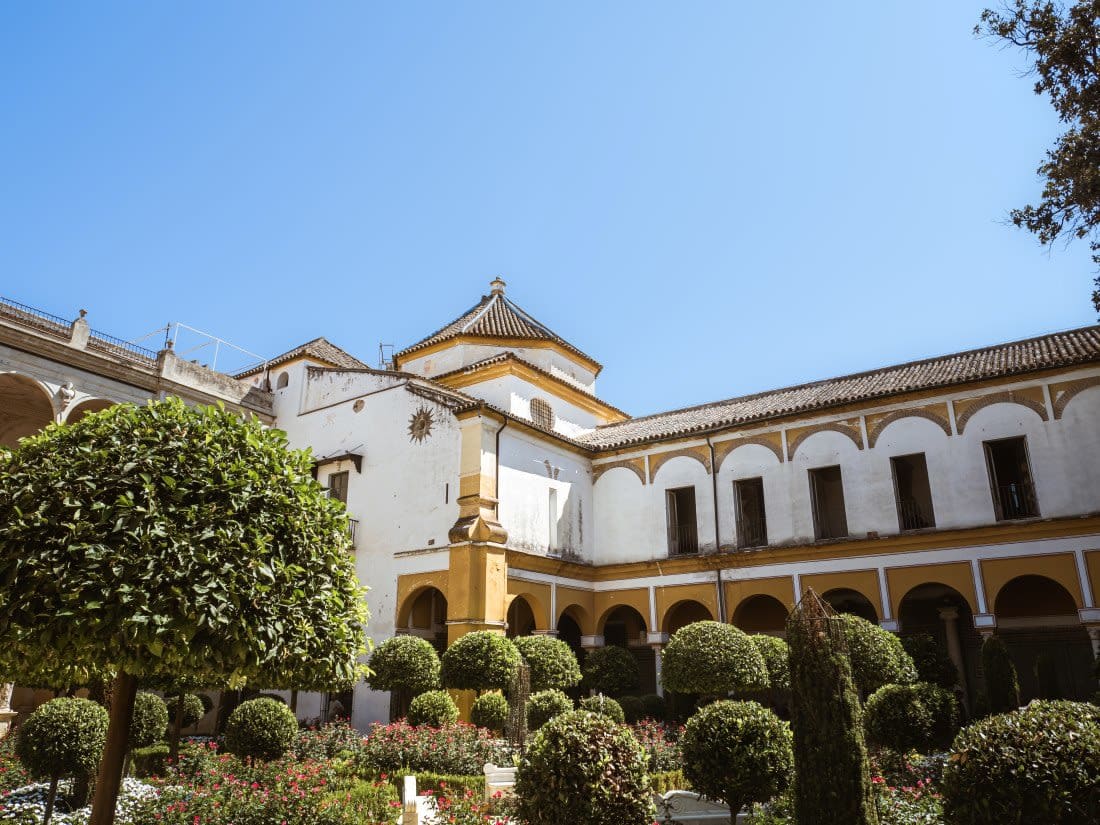
Casa de Pilatos
 Highlight of Casco Antiguo Norte
Highlight of Casco Antiguo NorteTour one of Seville's most magnificent architectural gems, the Casa de Pilatos.
The splendid Casa de Pilatos is a 16th-century palace renowned for its exquisite Mudéjar, Gothic, and Renaissance architectural elements. The palace features a stunning courtyard, richly decorated rooms, and a remarkable collection of ancient artifacts and artworks. It's a masterpiece of Seville's architectural heritage.
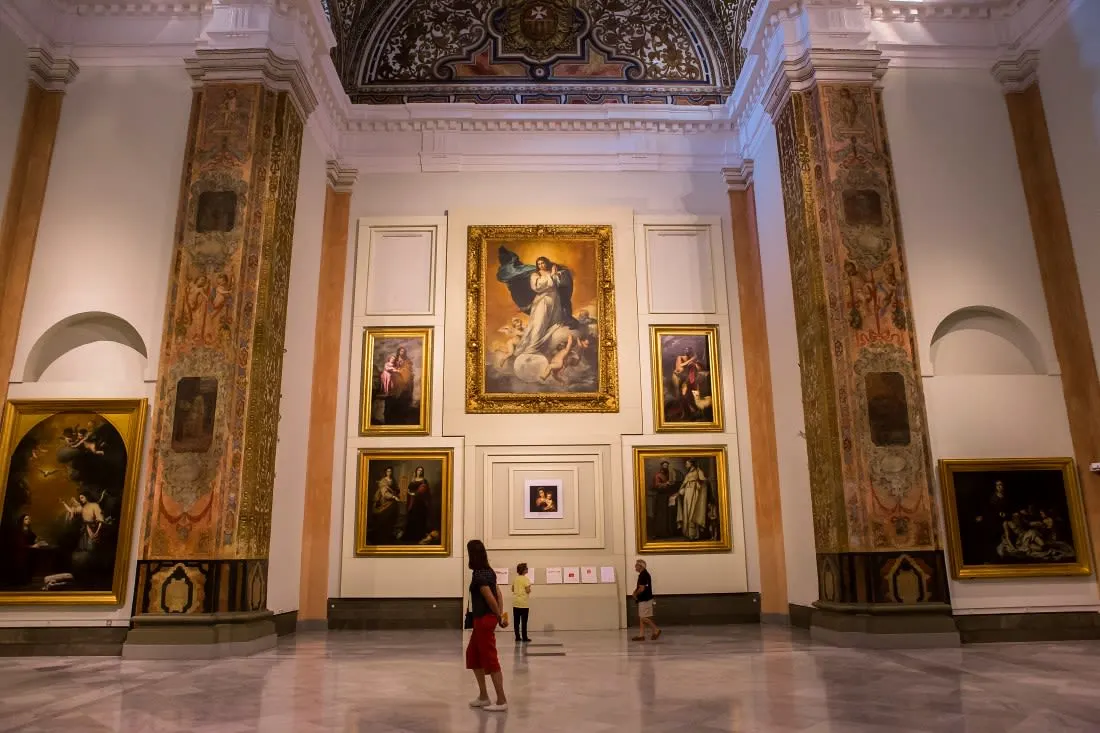
Museum of Fine Arts
 Highlight of Casco Antiguo Norte
Highlight of Casco Antiguo NorteAdmire Spanish masterpieces at the Museum of Fine Arts.
The Museum of Fine Arts' extensive collection of Spanish art is housed in a former convent. Established in 1839, the museum boasts works by renowned artists such as Murillo, Zurbarán, and Goya. The 17th-century building itself is a beautiful example of Baroque architecture, with tranquil courtyards and ornate interiors.
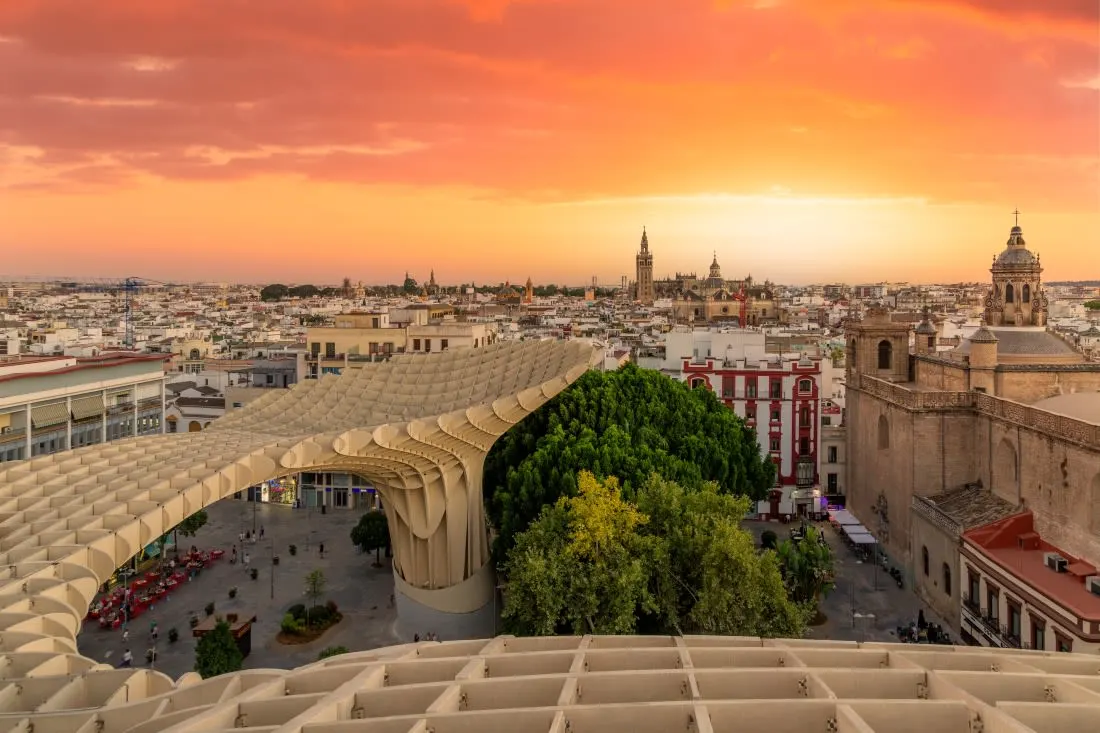
Setas de Sevilla
 Highlight of Casco Antiguo Norte
Highlight of Casco Antiguo NorteWalk above the rooftops of Seville on this strikingly modern wooden parasol.
Discover the contemporary Metropol Parasol, also known as "Las Setas," a striking wooden structure that offers panoramic views of Seville and covers one of the city's main squares. Completed in 2011, it features a lively market, archaeological museum, and rooftop walkway. It's a modern architectural icon blending history and innovation in the heart of the city.
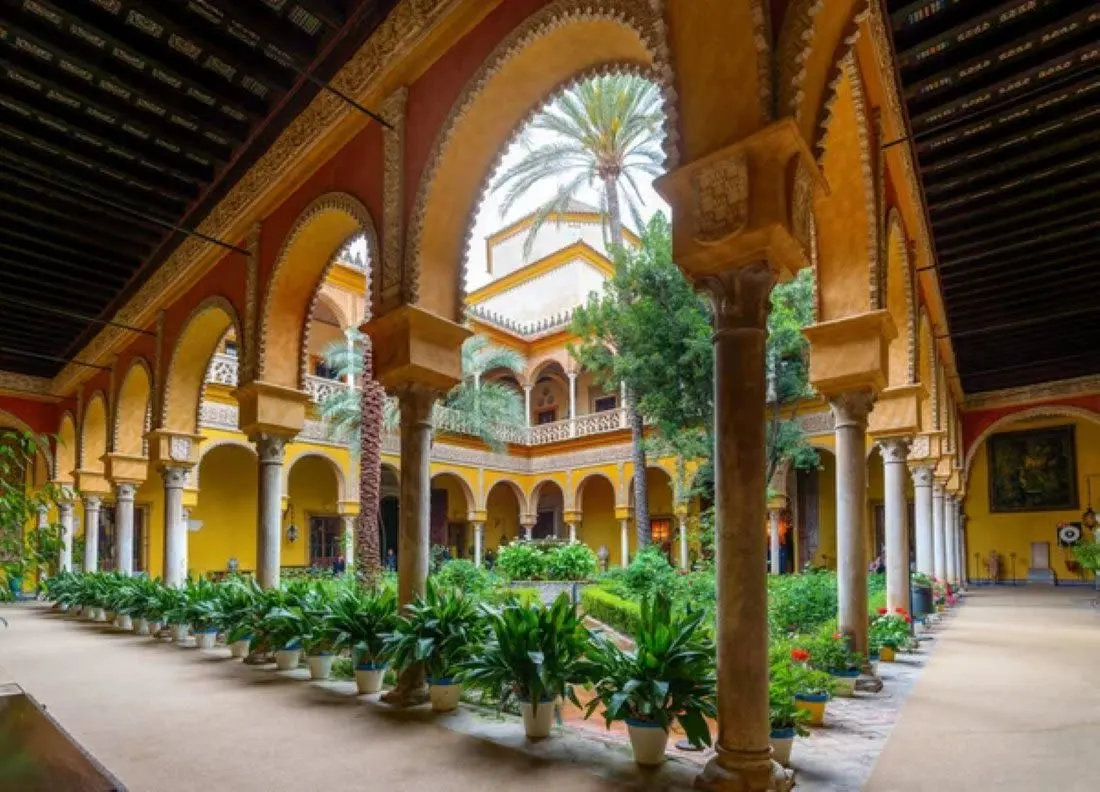
Duenas Palace
 Highlight of Casco Antiguo Norte
Highlight of Casco Antiguo NorteExplore the lavish Duenas Palace and its breathtaking gardens.
Although overshadowed by the Royal Alcazar and Casa de Pilatos, you may find the opulent Duenas Palace is your favorite place in Seville. The palace is a stunning example of Andalusian architecture with beautiful gardens, an excellent art collection, and an interesting history that dates back to the 15th century. This palace, once home to the Duchess of Alba, showcases a mix of Renaissance, Gothic, and Moorish styles that are not only beautiful, but perfectly preserved, creating a magical setting.

Alameda de Hércules
 Highlight of Casco Antiguo Norte
Highlight of Casco Antiguo NorteStroll a lively and wide boulevard that is also Seville's oldest public garden.
The Alameda de Hércules is a lively boulevard is adorned with Roman columns and statues of Hercules and is a hub of local culture and nightlife. It was established in 1574 as Seville's oldest public garden, but today it's an ideal spot to experience the city's vibrant social scene amidst locals and to enjoy various cafes and bars.

Casa de Pilatos
 Highlight of Casco Antiguo Norte
Highlight of Casco Antiguo NorteTour one of Seville's most magnificent architectural gems, the Casa de Pilatos.
The splendid Casa de Pilatos is a 16th-century palace renowned for its exquisite Mudéjar, Gothic, and Renaissance architectural elements. The palace features a stunning courtyard, richly decorated rooms, and a remarkable collection of ancient artifacts and artworks. It's a masterpiece of Seville's architectural heritage.

Museum of Fine Arts
 Highlight of Casco Antiguo Norte
Highlight of Casco Antiguo NorteAdmire Spanish masterpieces at the Museum of Fine Arts.
The Museum of Fine Arts' extensive collection of Spanish art is housed in a former convent. Established in 1839, the museum boasts works by renowned artists such as Murillo, Zurbarán, and Goya. The 17th-century building itself is a beautiful example of Baroque architecture, with tranquil courtyards and ornate interiors.

Setas de Sevilla
 Highlight of Casco Antiguo Norte
Highlight of Casco Antiguo NorteWalk above the rooftops of Seville on this strikingly modern wooden parasol.
Discover the contemporary Metropol Parasol, also known as "Las Setas," a striking wooden structure that offers panoramic views of Seville and covers one of the city's main squares. Completed in 2011, it features a lively market, archaeological museum, and rooftop walkway. It's a modern architectural icon blending history and innovation in the heart of the city.

Duenas Palace
 Highlight of Casco Antiguo Norte
Highlight of Casco Antiguo NorteExplore the lavish Duenas Palace and its breathtaking gardens.
Although overshadowed by the Royal Alcazar and Casa de Pilatos, you may find the opulent Duenas Palace is your favorite place in Seville. The palace is a stunning example of Andalusian architecture with beautiful gardens, an excellent art collection, and an interesting history that dates back to the 15th century. This palace, once home to the Duchess of Alba, showcases a mix of Renaissance, Gothic, and Moorish styles that are not only beautiful, but perfectly preserved, creating a magical setting.

Alameda de Hércules
 Highlight of Casco Antiguo Norte
Highlight of Casco Antiguo NorteStroll a lively and wide boulevard that is also Seville's oldest public garden.
The Alameda de Hércules is a lively boulevard is adorned with Roman columns and statues of Hercules and is a hub of local culture and nightlife. It was established in 1574 as Seville's oldest public garden, but today it's an ideal spot to experience the city's vibrant social scene amidst locals and to enjoy various cafes and bars.
prev
next

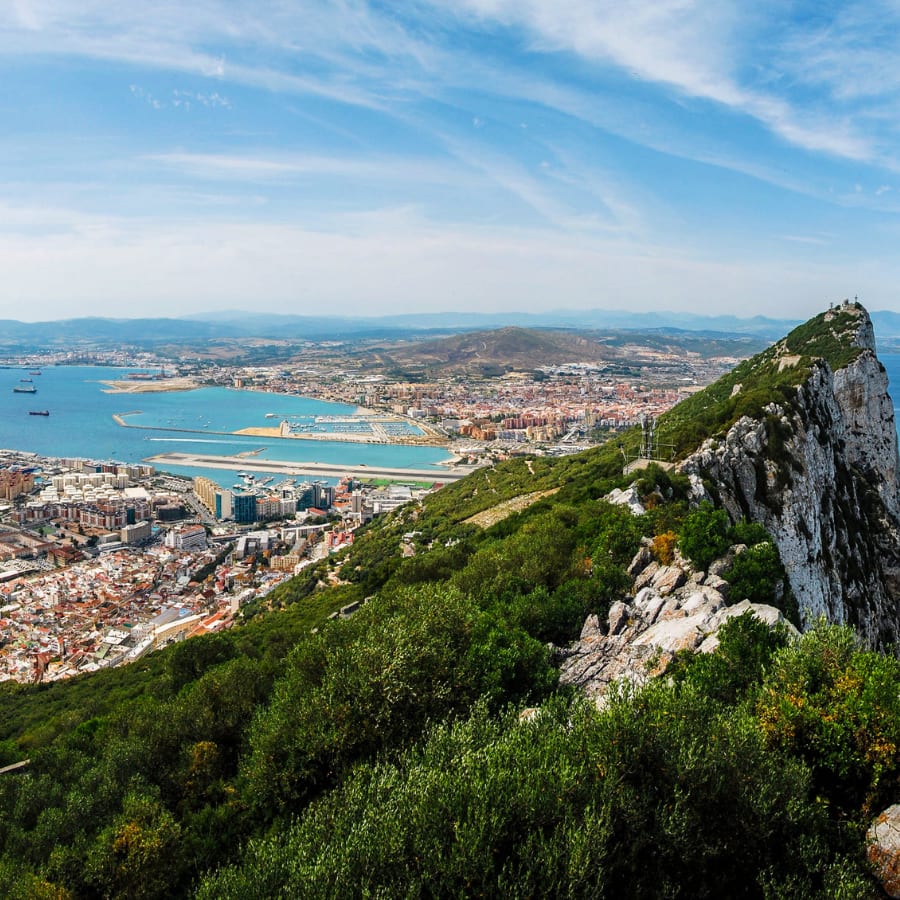
Day 9
Seville
View More
Day 9
Seville

9:00 AM - 7:00 PM
A visit to the British Enclave of Gibraltar
Embark on a unique adventure to Gibraltar, the iconic "Rock" that offers stunning views, rich history, and a vibrant cultural mix. Marvel at the breathtaking scenery from the Gibraltar Nature Reserve, explore the awe-inspiring San Miguel Caves, and meet the famous wild monkeys at the top of the Rock. Enjoy free time to shop and dine on bustling Main Street.

Day 9
Seville
View More



Day 10
Depart Seville
View More
Day 10
Depart Seville

To Be Determined
Airport Taxi Drop-off
The Aeropuerto de Seville rests about a 15-minute taxi ride from town (depending on your precise location). If you leave from your hotel 2 hours and 45 minutes before your flight, you should have a good amount of time to deposit bags and pass through security. In heavy traffic, the ride can last up to 40 mins. Depending on time of day, the ride will cost between 30 and 45 euros. Uber has a limited presence in Seville, but it is available.

Day 10
Depart Seville
View More


What's Included In Your Trip

Pre-Paid Tours and Activities:
- Medieval & Modernist, the Highlights of Barcelona Tour
- Highlights of Madrid Private Walking Tour
- Self-Guided Excursion to Majestic Toledo
- Guided Tour of the Highlights of Seville including the Royal Alcazar
- A visit to the British Enclave of Gibraltar
- City Card for Barcelona, including discounts to many popular attractions

Pre-Paid Transportation:
- 2nd Class Train Tickets from Barcelona-Madrid
- 2nd Class Train Tickets from Madrid to Seville
- Public Transport Tickets for Barcelona
- Private Transfer from Airport

Accommodation:
- 3 nights at a hotel of your choice in Barcelona
- 4 nights at a hotel of your choice in Madrid
- 5 nights at a hotel of your choice in Seville

Go Real Travel Mobile App:
- Itinerary Plan & Reservations Info
- Points of Interest
- Detailed Travel Information
- Maps & Directions
Other Trips You May Like

15 Days
From$5274USD
Southern European Treasures: A 15-Day Cultural Odyssey in Portugal, Spain & Italy

Portugal, Spain, Italy

14 Days
From$3679USD

15 Days
From$3832USD

5 Days
From$1699USD

10 Days
From$2595USD

21 Days
From$5160USD

21 Days
From$4999USD

7 Days
From$1725USD

10 Days
From$2599USD

15 Days
From$5274USD
Southern European Treasures: A 15-Day Cultural Odyssey in Portugal, Spain & Italy

Portugal, Spain, Italy

14 Days
From$3679USD

15 Days
From$3832USD

5 Days
From$1699USD

10 Days
From$2595USD

21 Days
From$5160USD

21 Days
From$4999USD

7 Days
From$1725USD

10 Days
From$2599USD
prev
next
Featured Blogs
prev
next
Our Customers Say It Best
Otto Chuy, Los Angeles, California
I am still surprised how everything worked as planned, without a hitch. All instructions in your itinerary were precise and correct. Your suggestions and comments in each of the locations we went to were very helpful. All your guides, without exception, were wonderful and exactly on time. 

Kathy Mongeau, Ottawa, Ontario
My sister, Ann Ibberson, and I have been back home for a few weeks now and still go on and on about our fabulous trip. We were just blown away in every respect. Given the fact that we only had 1 ½ weeks, you had everything arranged for us so efficiently and your contacts who we dealt with for transfers, tours, hotels were extremely professional and personable. Things could not have gone better. 

Clive Andrew, Brisbane, Queensland
Just a quick note to let you know that I am back home now after probably the best overseas holiday that I have ever had, in no small part due to your very capable organization booking of hotels, tours, & trains. There was just nothing that went wrong with the timings etc. 

Malini Dutta, Boston, Massachusetts
We can't thank you enough for the detailed plans, maps, and suggestions. It really felt that someone was holding our hands and showing us around. We had all the excitement of discovering foreign lands, with none of the problems that can happen while negotiating unfamiliar places. In fact, all the cities felt like home within a few hours of arriving and exploring. 

Bev and Mark Frankel, Williamsburg, Virginia
We could not be more pleased with Go Real Travel! You took the guess work out of things like public transport but still managed to allow us the freedom to tour as we wanted. Our guides were exceptional and every time I saw a Viking Cruise tour of 25 people, I realized the quality experience we were getting with Go Real. 

Marianne Strydom, Paarl, South Africa
I just wanted to thank you for organizing an amazing trip for me – I packed in so much in such a short period of time and everything was just perfect. The way you do things makes it possible to really get to know the destination, which for me as a travel agent could not have been better. 

Otto Chuy, Los Angeles, California
I am still surprised how everything worked as planned, without a hitch. All instructions in your itinerary were precise and correct. Your suggestions and comments in each of the locations we went to were very helpful. All your guides, without exception, were wonderful and exactly on time. 

Kathy Mongeau, Ottawa, Ontario
My sister, Ann Ibberson, and I have been back home for a few weeks now and still go on and on about our fabulous trip. We were just blown away in every respect. Given the fact that we only had 1 ½ weeks, you had everything arranged for us so efficiently and your contacts who we dealt with for transfers, tours, hotels were extremely professional and personable. Things could not have gone better. 

Clive Andrew, Brisbane, Queensland
Just a quick note to let you know that I am back home now after probably the best overseas holiday that I have ever had, in no small part due to your very capable organization booking of hotels, tours, & trains. There was just nothing that went wrong with the timings etc. 

Malini Dutta, Boston, Massachusetts
We can't thank you enough for the detailed plans, maps, and suggestions. It really felt that someone was holding our hands and showing us around. We had all the excitement of discovering foreign lands, with none of the problems that can happen while negotiating unfamiliar places. In fact, all the cities felt like home within a few hours of arriving and exploring. 

Bev and Mark Frankel, Williamsburg, Virginia
We could not be more pleased with Go Real Travel! You took the guess work out of things like public transport but still managed to allow us the freedom to tour as we wanted. Our guides were exceptional and every time I saw a Viking Cruise tour of 25 people, I realized the quality experience we were getting with Go Real. 

Marianne Strydom, Paarl, South Africa
I just wanted to thank you for organizing an amazing trip for me – I packed in so much in such a short period of time and everything was just perfect. The way you do things makes it possible to really get to know the destination, which for me as a travel agent could not have been better. 



Explore cities in more detail
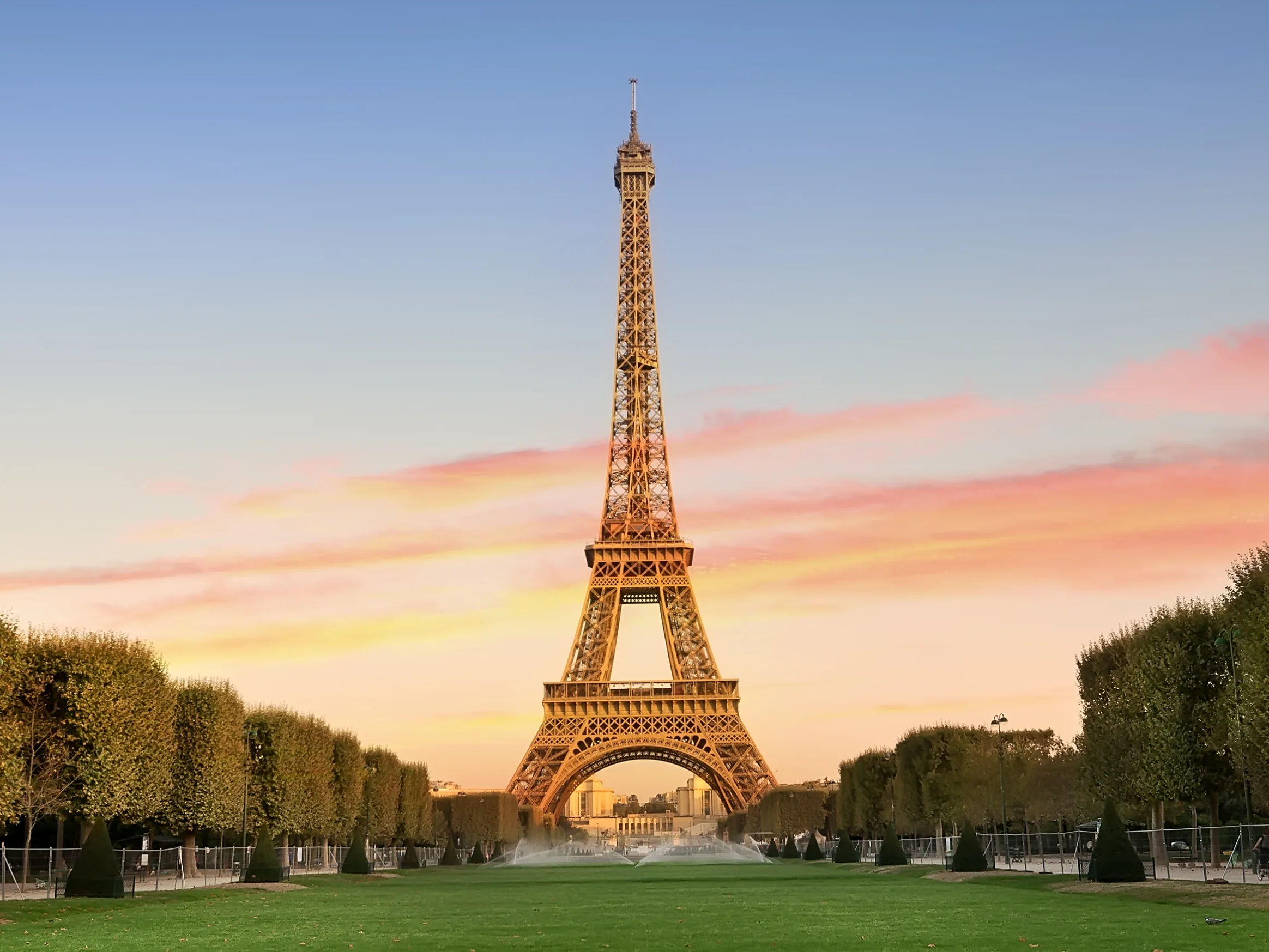
Paris
The magic of Paris is undeniable. This is the most romantic destination in Europe, and surely the number one bucket list destination of all time. If you want to say you've traveled, you have to visit Paris at least once. Along with classic must-sees like the Eiffel Tower and the Sacre-Coeur, there is so much to see and do in Paris that it helps to narrow it down by interest. Fashion and shopping enthusiast? Look no further than the Galeries Lafayette, Avenue des Champs-Élysées, or the Marais. Art aficionado? Once you're done with the Louvre, make a start on the Musée d'Orsay. History buffs won't be able to walk a block without uncovering a monument to Napoleon or Louis XIV. If you visit Paris with a foodie, be warned — you'll gaze in a lot of patisserie windows, and sample your weight in croissants. Because Paris always has so much on offer, it never grows old. At dusk, as you stroll the wide boulevards past Haussmann apartment buildings and sharply dressed Parisians, or gaze down at the city from the hill at Montmarte, you might find yourself saying 'Paris Je t' aime'. This is, after all, the City of Love.
Read More
Learn About Paris
Build Paris Trip
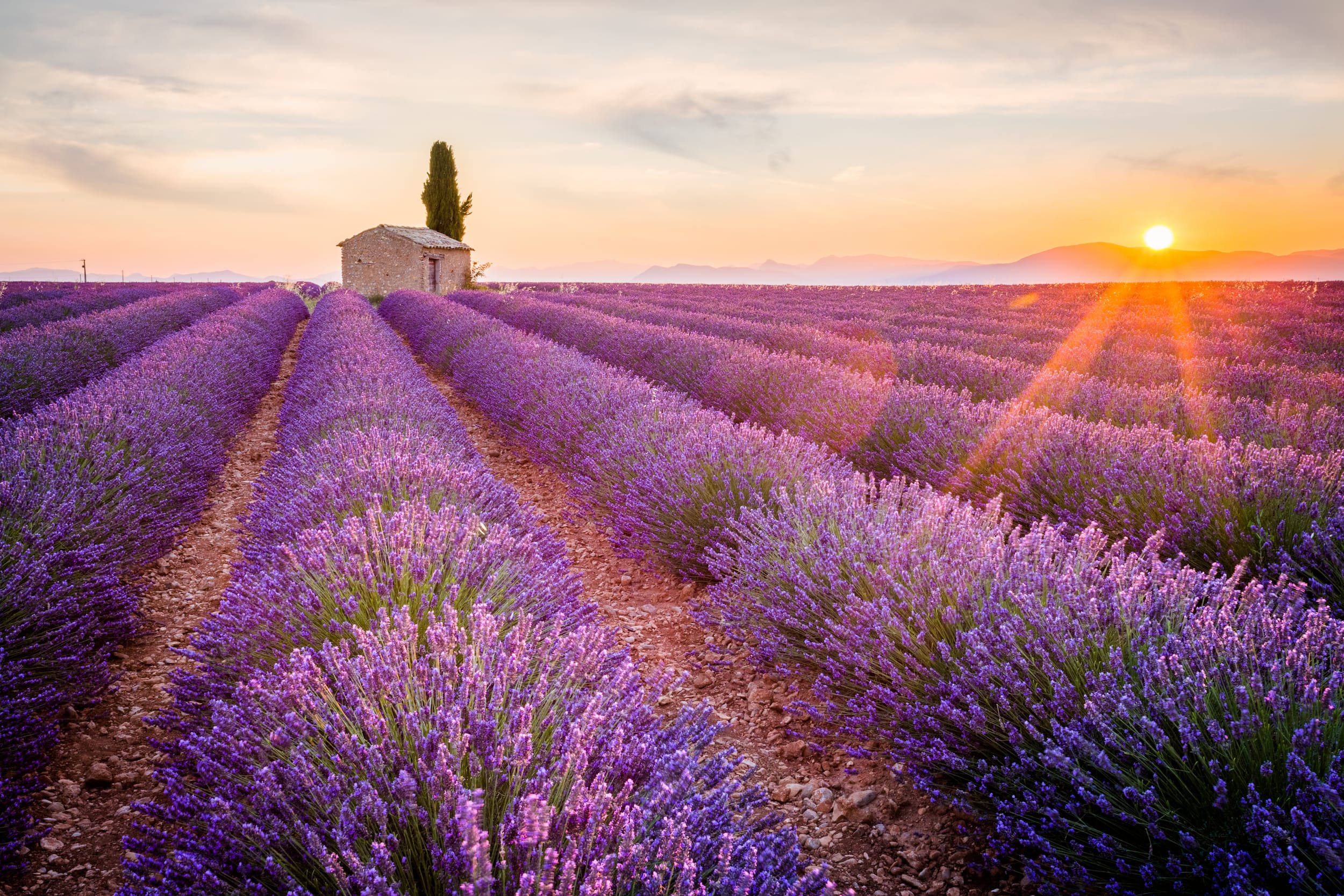
Aix en Provence
Aix en Provence is a warm city baked into the Provence-Alpes-Côte region of Southern France. Often referred to as simply ‘Aix’, this city is a starting point for traveling the Provencal region. Aix is set amongst a backdrop of rambling vineyards, quaint villages, and the imposing Sainte-Victoire mountain range. It’s no surprise that artists like Cézanne have devoted lifetimes to painting this landscape. Aromatic lavender fields in the north blossom once a year with a scent that defines the French countryside. Head south and you’ll find the rocky Mediterranean shore with dramatic Calanques cliffs and clear blue waters. With the sun out nearly all year round, locals live the epitome of the Mediterranean lifestyle. Wander through narrow medieval streets, shop at lively marketplaces, and enjoy a glass of rosé on a cafe terrace beneath the gentle Provencal sun. From old-world architecture and bubbling fountains to refined galleries and leafy parks, this leisurely city has everything you could ask of a French vacation.
Read More
Learn About Aix en Provence
Build Aix en Provence Trip
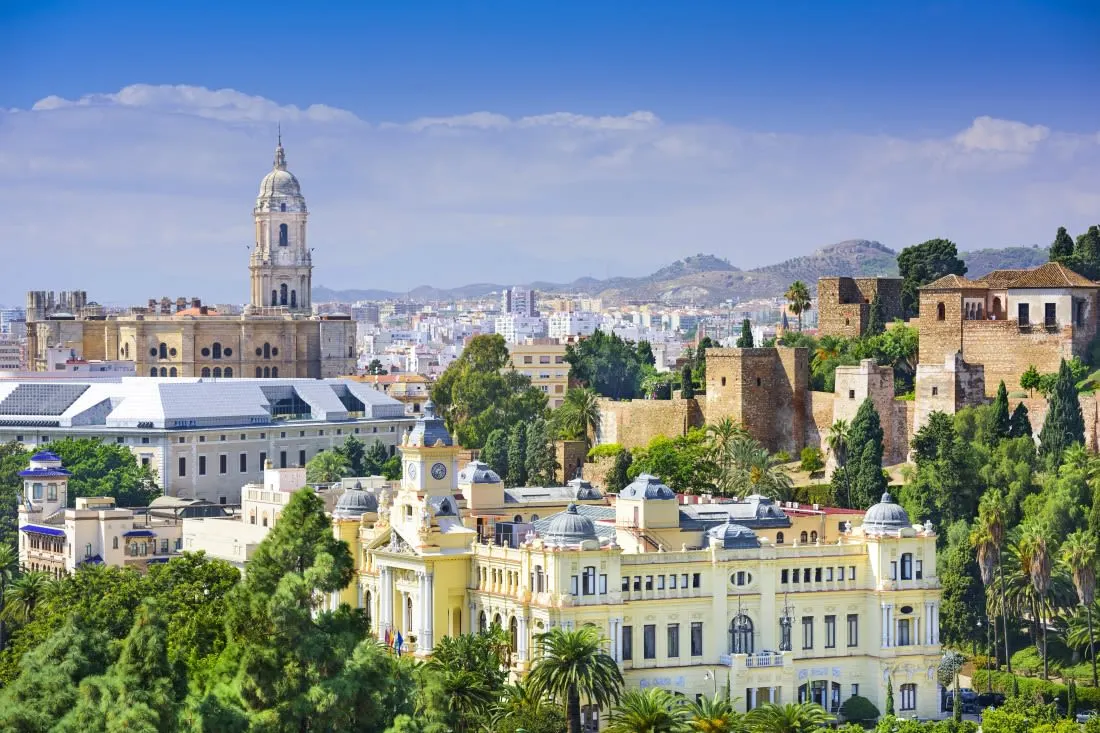
Malaga
Málaga, a gem on Spain’s sun-drenched Costa del Sol, is a city that effortlessly blends the charm of its Moorish past with the vibrancy of modern Mediterranean life. Nestled between the azure waves of the Alboran Sea and the rolling hills of Andalusia, Málaga invites you to explore its rich history, from the ancient Alcazaba fortress to the birthplace of Picasso. Wander through bustling plazas lined with palm trees, sip sangria at a beachside chiringuito, and feast on fresh seafood at the lively Atarazanas Market. This city is a sensory delight where sun-kissed days melt into nights buzzing with flamenco rhythms and the laughter of locals enjoying late-night tapas. Whether you're seeking cultural treasures, coastal relaxation, or a taste of Andalusian zest, Málaga promises a vibrant, warm, and unforgettable escape.
Read More
Learn About Malaga
Build Malaga Trip

Barcelona
Barcelona, the cosmopolitan capital of Catalonia, is a city that dances to a rhythm of its own. Known for its architectural wonders and vibrant street life, this city is a tapestry of rich history and contemporary culture. Wander through its bustling streets and you'll feel the pulse of heritage and innovation beating as one. From the awe-inspiring Sagrada Familia to the colorful mosaics of Park Guell, Barcelona offers endless avenues to explore and discover. As the sun sets, the city transforms into a lively spectacle of lights and shadows, inviting you to indulge in its culinary delights and spirited nightlife. Whether you’re soaking up the Mediterranean sun on its beaches or exploring its Gothic quarters, Barcelona promises an unforgettable journey that will captivate your heart and stir your soul.
Read More
Learn About Barcelona
Build Barcelona Trip
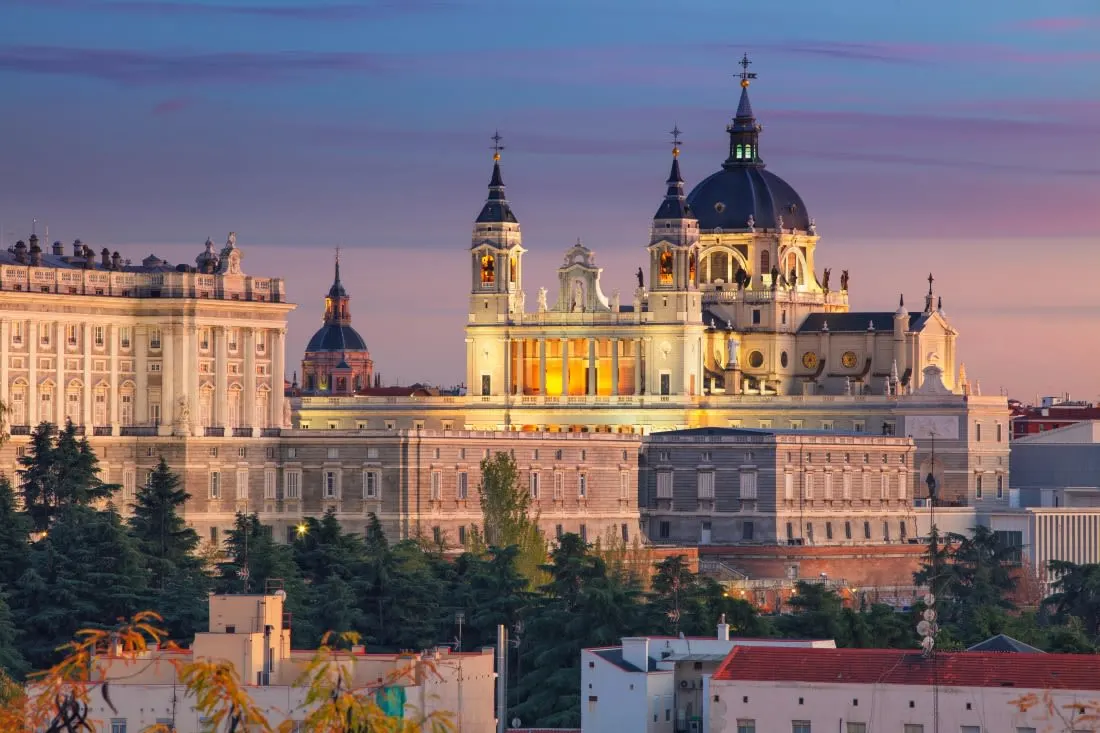
Madrid
What are the best Madrid recommendations for Madrid travel? Take two parts culture, two part history, douse it with art, sprinkle it all with lots of Spanish zest, and live vigorously: That's the recipe for Madrid, Spain's capital. Let Go Real be your guide to Madrid, the city alive with the rhythms of passionate flamenco on its cosmopolitan streets, inviting travelers into its warm embrace. Here, art enthusiasts can lose themselves in the hallowed halls of the Prado Museum, home to masterpieces by Velázquez, Goya, and El Greco, while the Reina Sofia and Thyssen-Bornemisza museums complete Madrid's famed Art Triangle, offering a journey through centuries of art history. The city's culinary scene is equally compelling, with tapas bars and bustling markets like Mercado San Miguel offering a taste of Spain's rich gastronomic heritage through an array of tapas, wines, and cheeses. Madrid's architectural splendor is evident in its royal palaces, ornate plazas, and expansive parks, such as the Retiro, a green oasis in the heart of the city where locals and tourists alike find respite by its serene lake. As night falls, Madrid's streets come alive with an infectious energy, from the historic tapas bars in the Latina district to the chic dancehalls in Malasaña and Chueca, reflecting the city's open-hearted spirit and its inhabitants' joie de vivre. With Go Real's Madrid sightseeing guide and using our Madrid tips, you will find the best place to bask in the sun at a lively terrace café, explore the treasures of the Hapsburg Madrid, or discover your own precious finds at Rastro's flea market. With our best Madrid travelguide, the city offers an endless array of experiences that beckon the curious traveler to taste its many charms.
Read More
Learn About Madrid
Build Madrid Trip
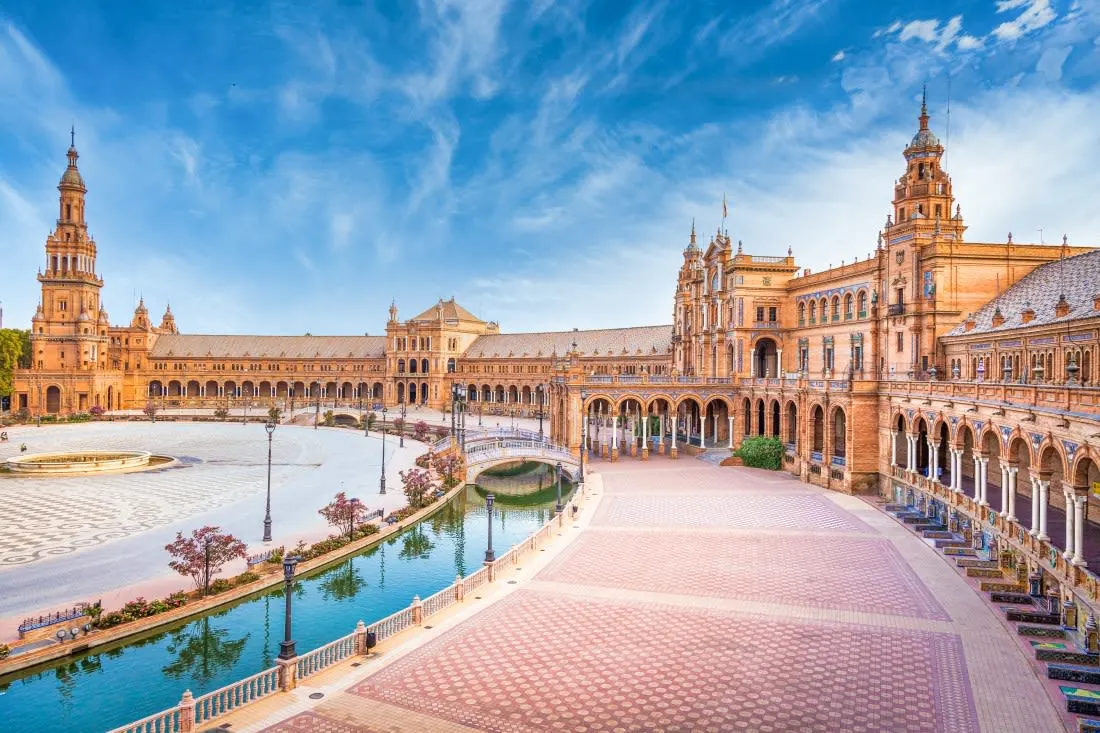
Seville
Seville, the capital of Spain's Andalusia region, is a city rich in history and culture. Architectural marvels like Plaza de España, Seville Cathedral, and the Alcazar reflect its storied past, while its vibrant cuisine and flamenco music showcase its lively present. Key landmarks include the Giralda, a minaret turned bell tower, and the bustling old town, filled with narrow streets, traditional tapas bars, and lively plazas. Whether exploring historical sites or savoring local flavors, Seville captivates with its spirited atmosphere and colorful heritage, making it a true center of Spanish culture and tradition.
Read More
Learn About Seville
Build Seville Trip

Paris
The magic of Paris is undeniable. This is the most romantic destination in Europe, and surely the number one bucket list destination of all time. If you want to say you've traveled, you have to visit Paris at least once. Along with classic must-sees like the Eiffel Tower and the Sacre-Coeur, there is so much to see and do in Paris that it helps to narrow it down by interest. Fashion and shopping enthusiast? Look no further than the Galeries Lafayette, Avenue des Champs-Élysées, or the Marais. Art aficionado? Once you're done with the Louvre, make a start on the Musée d'Orsay. History buffs won't be able to walk a block without uncovering a monument to Napoleon or Louis XIV. If you visit Paris with a foodie, be warned — you'll gaze in a lot of patisserie windows, and sample your weight in croissants. Because Paris always has so much on offer, it never grows old. At dusk, as you stroll the wide boulevards past Haussmann apartment buildings and sharply dressed Parisians, or gaze down at the city from the hill at Montmarte, you might find yourself saying 'Paris Je t' aime'. This is, after all, the City of Love.
Read More
Learn About Paris
Build Paris Trip

Aix en Provence
Aix en Provence is a warm city baked into the Provence-Alpes-Côte region of Southern France. Often referred to as simply ‘Aix’, this city is a starting point for traveling the Provencal region. Aix is set amongst a backdrop of rambling vineyards, quaint villages, and the imposing Sainte-Victoire mountain range. It’s no surprise that artists like Cézanne have devoted lifetimes to painting this landscape. Aromatic lavender fields in the north blossom once a year with a scent that defines the French countryside. Head south and you’ll find the rocky Mediterranean shore with dramatic Calanques cliffs and clear blue waters. With the sun out nearly all year round, locals live the epitome of the Mediterranean lifestyle. Wander through narrow medieval streets, shop at lively marketplaces, and enjoy a glass of rosé on a cafe terrace beneath the gentle Provencal sun. From old-world architecture and bubbling fountains to refined galleries and leafy parks, this leisurely city has everything you could ask of a French vacation.
Read More
Learn About Aix en Provence
Build Aix en Provence Trip

Malaga
Málaga, a gem on Spain’s sun-drenched Costa del Sol, is a city that effortlessly blends the charm of its Moorish past with the vibrancy of modern Mediterranean life. Nestled between the azure waves of the Alboran Sea and the rolling hills of Andalusia, Málaga invites you to explore its rich history, from the ancient Alcazaba fortress to the birthplace of Picasso. Wander through bustling plazas lined with palm trees, sip sangria at a beachside chiringuito, and feast on fresh seafood at the lively Atarazanas Market. This city is a sensory delight where sun-kissed days melt into nights buzzing with flamenco rhythms and the laughter of locals enjoying late-night tapas. Whether you're seeking cultural treasures, coastal relaxation, or a taste of Andalusian zest, Málaga promises a vibrant, warm, and unforgettable escape.
Read More
Learn About Malaga
Build Malaga Trip

Barcelona
Barcelona, the cosmopolitan capital of Catalonia, is a city that dances to a rhythm of its own. Known for its architectural wonders and vibrant street life, this city is a tapestry of rich history and contemporary culture. Wander through its bustling streets and you'll feel the pulse of heritage and innovation beating as one. From the awe-inspiring Sagrada Familia to the colorful mosaics of Park Guell, Barcelona offers endless avenues to explore and discover. As the sun sets, the city transforms into a lively spectacle of lights and shadows, inviting you to indulge in its culinary delights and spirited nightlife. Whether you’re soaking up the Mediterranean sun on its beaches or exploring its Gothic quarters, Barcelona promises an unforgettable journey that will captivate your heart and stir your soul.
Read More
Learn About Barcelona
Build Barcelona Trip

Madrid
What are the best Madrid recommendations for Madrid travel? Take two parts culture, two part history, douse it with art, sprinkle it all with lots of Spanish zest, and live vigorously: That's the recipe for Madrid, Spain's capital. Let Go Real be your guide to Madrid, the city alive with the rhythms of passionate flamenco on its cosmopolitan streets, inviting travelers into its warm embrace. Here, art enthusiasts can lose themselves in the hallowed halls of the Prado Museum, home to masterpieces by Velázquez, Goya, and El Greco, while the Reina Sofia and Thyssen-Bornemisza museums complete Madrid's famed Art Triangle, offering a journey through centuries of art history. The city's culinary scene is equally compelling, with tapas bars and bustling markets like Mercado San Miguel offering a taste of Spain's rich gastronomic heritage through an array of tapas, wines, and cheeses. Madrid's architectural splendor is evident in its royal palaces, ornate plazas, and expansive parks, such as the Retiro, a green oasis in the heart of the city where locals and tourists alike find respite by its serene lake. As night falls, Madrid's streets come alive with an infectious energy, from the historic tapas bars in the Latina district to the chic dancehalls in Malasaña and Chueca, reflecting the city's open-hearted spirit and its inhabitants' joie de vivre. With Go Real's Madrid sightseeing guide and using our Madrid tips, you will find the best place to bask in the sun at a lively terrace café, explore the treasures of the Hapsburg Madrid, or discover your own precious finds at Rastro's flea market. With our best Madrid travelguide, the city offers an endless array of experiences that beckon the curious traveler to taste its many charms.
Read More
Learn About Madrid
Build Madrid Trip

Seville
Seville, the capital of Spain's Andalusia region, is a city rich in history and culture. Architectural marvels like Plaza de España, Seville Cathedral, and the Alcazar reflect its storied past, while its vibrant cuisine and flamenco music showcase its lively present. Key landmarks include the Giralda, a minaret turned bell tower, and the bustling old town, filled with narrow streets, traditional tapas bars, and lively plazas. Whether exploring historical sites or savoring local flavors, Seville captivates with its spirited atmosphere and colorful heritage, making it a true center of Spanish culture and tradition.
Read More
Learn About Seville
Build Seville Trip
prev
next


 Map of Your Itinerary Route
Map of Your Itinerary Route
Zoom In to the cities to see your itinerary in more detail


 4.8
4.8 
